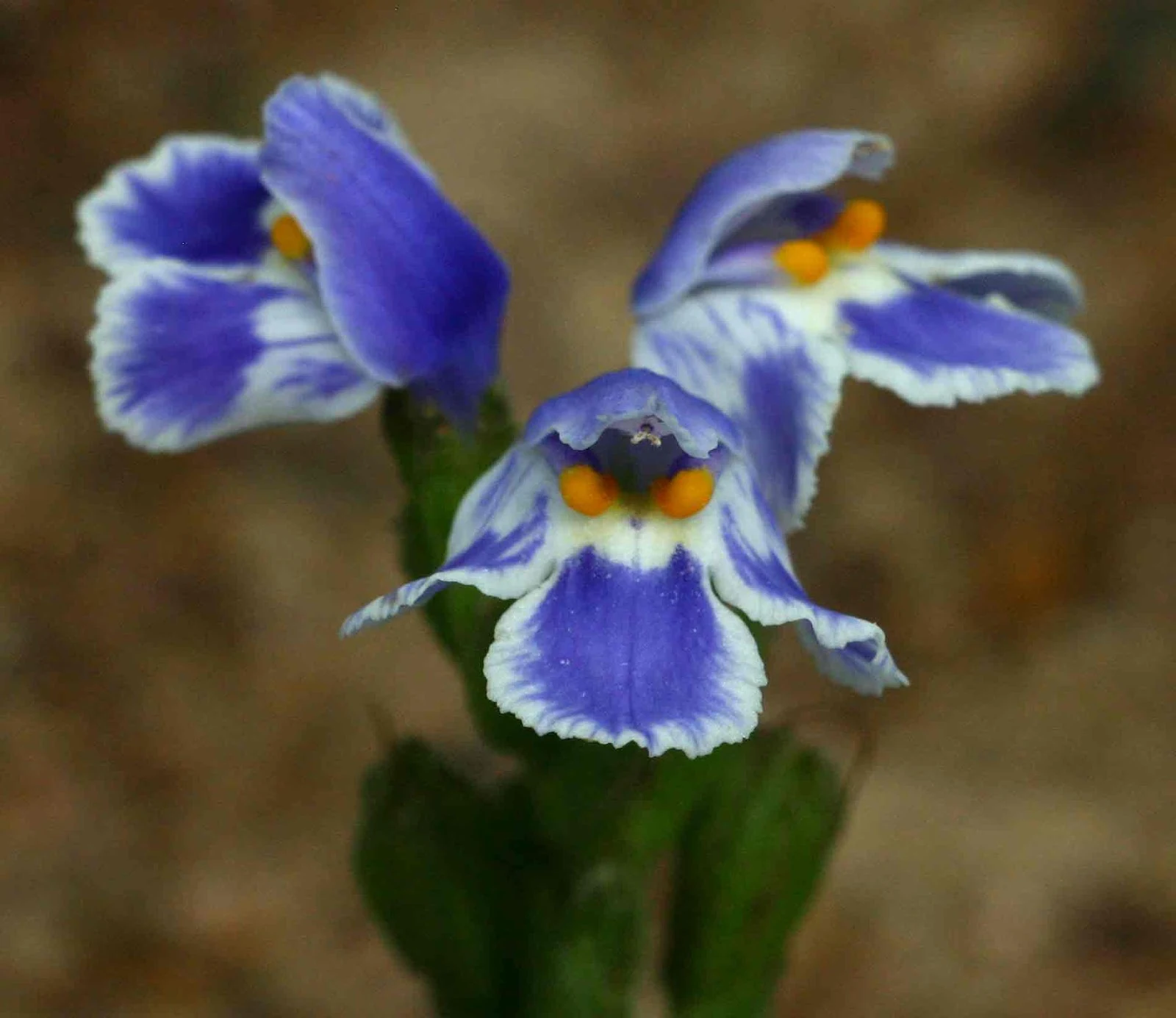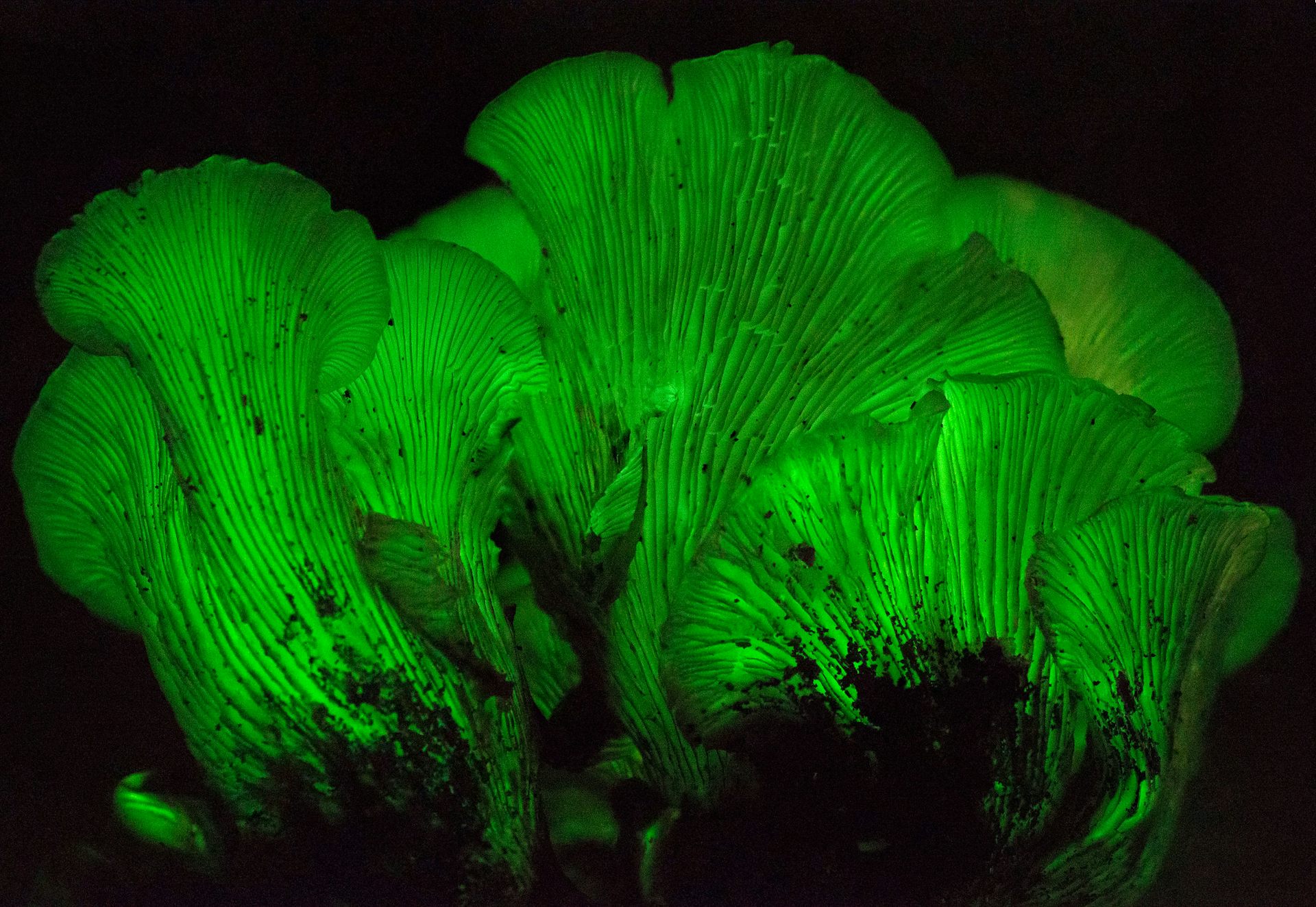Religion, Creationism, evolution, science and politics from a centre-left atheist humanist. The blog religious frauds tell lies about.
Showing posts with label Botany. Show all posts
Showing posts with label Botany. Show all posts
Wednesday 23 August 2023
Creationism in Crisis - How a Deleterious Gene Can Survive in a Population
It all depends on the genetic diversity | Max Planck Institute for Chemical Ecology
Mutations in genes that are essential for defence against predator attack are usually deleterious and would be expected to be quickly eliminated from a population, however, occasionally, the same mutation can convey an advantage which it is able to assert in conditions where predator populations are low, and this is especially true if wide genetic diversity within the population makes it more likely that the mutation can operate synergistically with other genes.
This can lead to a dynamic situation in which, in periods of low predation, the mutation can increase, or at least remain at a stable level in the population, and, in periods of high predation, it can be reduced. This dynamic can result in deleterious genes being retained in a population for much longer than would be expected if they were wholly deleterious.
An example of this was found recently by researchers from the Max Planck Institute for Chemical Ecology, Jena, Germany, in a wild member of the tobacco family, Nicotiana attenuata. Their finding is published in Proceedings of the National Academy of Science (PNAS)
The research and its significance are explained in a press release:
Monday 24 July 2023
Creationism in Crisis - It's More of Those Transitional Fossils And the Japanese Scientists Call It Evolution
Exposed riverbed from where the fossils were found.
Photo: Toshihiro Yamada
Miocene period fossil forest of Wataria found in Japan | Hokkaido University
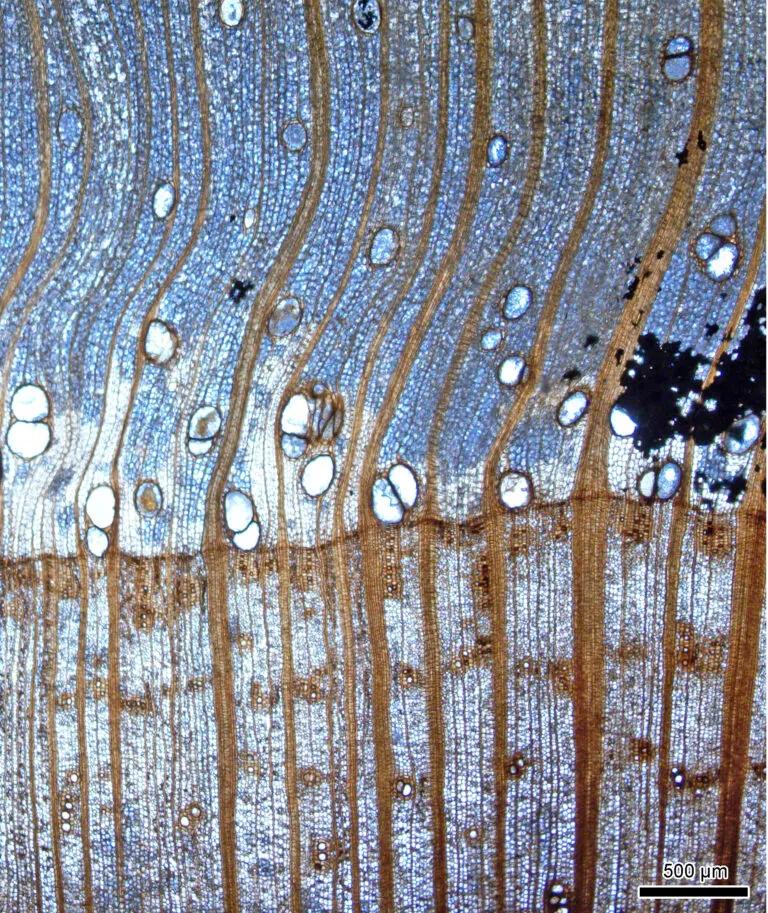
Wataria parvipora showing annual rings. It is one of the characteristics that helped the scientists in identifying the wood-fossil.
This creates a problem for the cult leaders who have to keep devising strategies for ignoring all the many examples of transitional fossils that palaeontologists keep unearthing; one of which is to claim that the transitional fossil is that of a fully formed species, which works on people who think evolution means one taxon turns into a different taxon such as cats turning into dogs or crocodiles into ducks, or, in the case of humans (the (non)evolution of whom is a special obsession with creationists), a chimpanzee turning into a fully modern human.
For a laugh, try asking a creationist to describe exactly what they would expect a transitional fossil to look like!
Anyway, this article is about examples of transitional fossil plants that have been found in an especially well-preserved fossilised Miocene Forest in an exposed bed of the Kiso River. The river level was subject to an unprecedented drought in 1994 which exposed 400 fossilized tree stumps. The stumps are now inundated again but not before a research group led by Professor Toshihiro Yamada of the Department of Earth and Planetary Sciences, Hokkaido University, had analysed 137 stumps, of which 130 were identified as Wataria parvipora. The stumps were covered in leaves identified as Byttneriophyllum The Hokkaido University news release 3xplains the research and its significance:
Labels:
Biology
,
Botany
,
Creationism in Crisis
,
Evolution
,
Palaeontology
,
Science
Monday 3 July 2023
Unintelligent Designer News - How Trees Evolved Sub-optimal and Complex Seed Dispersal Mechanisms
Slideshow code developed in collaboration with ChatGPT3 at https://chat.openai.com/
A seed survival story: How trees keep ‘friends’ close and ‘enemies’ guessing | Penn State University
Back in November 2013 (was it really nearly ten years ago?!) I wrote a blog post which anticipated this latest piece of research. It was all about how a symbiotic relationship between birds and flowering plants had evolved in which the plants provide birds with food in exchange for them dispersing their seeds, and how this incidentally led to us evolving colour vision. Now this research by a large international team led by Assistant Professor Tong Qiu, of the College of Agricultural Sciences, Penn State University, has looked at the dynamics of this relationship in which trees need to balance the loss of seeds by consumption and their dispersal by those same consumers, and how this balance can change in years of plenty (mast years) and lean years.
The relationship is complex and sub-optimal, exactly as might be expected of an evolved system, but not of an intelligently designed system, which would be optimized and minimally complex to avoid the unnecessary waste of the naturally evolved system. Climate too plays a part in the complex, especially the occurrence of summer drought.
The research is explained in a Penn State News release:
Labels:
Biology
,
Botany
,
Creationism
,
Evolution
,
Science
,
Unintelligent Design
Tuesday 28 March 2023
Creationism in Crisis - Scientists Have Discovered How Plants Evolved About 420 Million Years Ago
Creationism in Crisis
Scientists Have Discovered How Plants Evolved About 420 Million Years Ago
Scientists Have Discovered How Plants Evolved About 420 Million Years Ago
Selaginella
Photo: Vicky Spencer
March: Origin of plants | News and features | University of Bristol
News today of yet another casual and incidental refutation of some of the Creation cult's fundamentals.
First, a little anecdote from one of my previous lives.
Back in the 1980's I was managing a rural ambulance station, a role which included manning an emergency ambulance as part of a crew of two, so I spent a lot of time with a regular crew mate who was a fundamentalist Creationist 7th Day Adventist.
We rarely spoke about religion (in the UK religion is a private matter and not a suitable subject for discussion in the workplace and anyway, he regarded me as a lost cause, Satan having blinded me with science) but somehow we had got onto the subject of everything in nature being designed by God, and to illustrate his point, my crewmate pointed to a small holly tree that was growing near the front entrance to the station and said its growth pattern was set by God so it would grow according to his plan ("Look at the trees!" Yes, that was the level of his theology). It was Spring and the tree was in active growth.
So I asked if I would be able to change God's plan by changing the growth pattern of the tree. "Of course not! That would make you more powerful than God, and nothing can be!"
In an even earlier life, I had been a senior medical research technician and had studied plant physiology, amongst other sciences, as part of my degree course, so I knew a little bit about plant hormones called gibberellins and auxins.
So, I pointed out that if you look at a growing shoot, you will notice that the side shoots get longer the further away they are from the growing tip. I then snipped off the tip of the growing shoot with a pair of scissors and told him to watch what happened over the next few days. After a few days it was obvious that side-shoots were now forming and growing quickly near what had been the growing tip with the longer shoots now closer to the tip in the reverse of what was the normal pattern of growth. I had changed his god's plan, apparently and reversed the growth pattern of a holly tree.
Over the next few weeks, I saw my crew mate frequently examining the holly tree and snipping off growing shoot himself.
Eventually, he conceded that I (and now he) could change the growth pattern of a holly tree, and asked my how it had happened. I explained that the cells in the growing tip (the meristem cells that were differentiating into the different cell types as the shoot grew) produced a type of hormone called auxin which inhibited the side shoots closer to the tip but its effects were diluted lower down the shoot and eventually, in low concentration, they were growth stimulants. By clipping off the tip, we had removed the hormone, so the previously inhibited side shoots were now free to grow. The growth pattern is not controlled by his god but by physiological processes.
Eventually, my crew mate concluded that his god had devised the hormone system so we weren't playing God and tinkering with his plan for the holly tree after all. God was safely back in the growing tips of the holly tree where he belonged, according to 7th Day Adventists.
You can lead a horse to water…
That was by way of an introduction to the work of scientists from Bristol University, UK, who have discovered how the earliest vascular plants evolved the ability to branch - a key development in the evolution of multicellular plants. What they have discovered is fundamental to distantly-related plants, strongly indicating common ancestry.
To make matters worse for Creationists, it all happened over 400 million years before they believe the Universe existed!
Labels:
Biology
,
Botany
,
Creationism in Crisis
,
Evolution
,
Science
Sunday 26 March 2023
Creationism in Crisis - How the 'Resurrection Plant' Evolved Its Special Ability to Survive Dehydration
Creationism in Crisis
How the 'Resurrection Plant' Evolved Its Special Ability to Survive Dehydration
How the 'Resurrection Plant' Evolved Its Special Ability to Survive Dehydration
'Resurrection plant, Craterostigma plantagineum
Creationism in Crisis
How the 'Resurrection Plant' Evolved Its Special Ability to Survive Dehydration
How the 'Resurrection Plant' Evolved Its Special Ability to Survive Dehydration
'Resurrection plant, Craterostigma plantagineum
Creationism in Crisis
How the 'Resurrection Plant' Evolved Its Special Ability to Survive Dehydration
How the 'Resurrection Plant' Evolved Its Special Ability to Survive Dehydration
'Resurrection plant, Craterostigma plantagineum
Creationism in Crisis
How the 'Resurrection Plant' Evolved Its Special Ability to Survive Dehydration
How the 'Resurrection Plant' Evolved Its Special Ability to Survive Dehydration
'Resurrection plant, Craterostigma plantagineum
Creationism in Crisis
How the 'Resurrection Plant' Evolved Its Special Ability to Survive Dehydration
How the 'Resurrection Plant' Evolved Its Special Ability to Survive Dehydration
'Resurrection plant, Craterostigma plantagineum
Creationism in Crisis
How the 'Resurrection Plant' Evolved Its Special Ability to Survive Dehydration
How the 'Resurrection Plant' Evolved Its Special Ability to Survive Dehydration
'Resurrection plant, Craterostigma plantagineum
Many genes are involved in “resurrection” — University of Bonn
If they are to survive in an environment subject to prolonged periods of dry weather, plants need to be able to survive without water for long periods and then spring back to life again when the rains come.
Ho they do this was the subject of a recent study by researchers from the universities of Bonn and Düsseldorf, Germany, and Michigan, USA, and, not surprisingly to anyone who understands biology, they found that the genes giving the so-called resurrection plant, Craterostigma plantagineum, this ability evolved out of genes also present in other plants.
In doing so, they exposed the Creationist claim that no new information can arise in a species genome without magic, otherwise it violates a fundamental law of physics, the Second Law of Thermodynamics [sic], forgetting for a moment that even with magic, that Law would still be violated, assuming for the sake of argument that it has anything to do with the amount of information in a species genome. It doesn't, of course, but the frauds who feed their cult with that sort of scientific gobbledygook know they love to think they sound all sciency and knowledgeable, but, like parrots, won't understand the noises they are making.

The resurrection plant Craterostigma plantagineum - in irrigated
condition (left), desiccated (center), and then "resurrected" (right).
Photo: © AG Bartels/University of Bonn
C. plantagineum is an octoploid species, meaning that unlike most plants and all mammals which have just two copies of each gene, C. plantagineum has eight. At some point during its evolution, C. plantagineum doubled its genome, then doubled it again.
This gives the plant the ability to rapidly makes lots of the enzymes needed to kick-start growth after dehydration.
But that's not all. The plants have multiple copies of other genes involved in the kick-start process - the “early light inducible proteins” (ELIPs); in some cases about 200 copies, in several small clusters in their genome. These are rapidly activated by light and protect the cells from oxidative stress.
As the News release from Bonn University explains:
Labels:
Biology
,
Botany
,
Creationism in Crisis
,
Evolution
,
Science
Monday 20 March 2023
Creationism in Crisis - A Rare Orchid Hiding in Plain Sight, And Scientists Work Out Its Evolution
Creationism in Crisis
A Rare Orchid Hiding in Plain Sight, And Scientists Work Out Its Evolution
A Rare Orchid Hiding in Plain Sight, And Scientists Work Out Its Evolution
Creationism in Crisis
A Rare Orchid Hiding in Plain Sight, And Scientists Work Out Its Evolution
A Rare Orchid Hiding in Plain Sight, And Scientists Work Out Its Evolution
Creationism in Crisis
A Rare Orchid Hiding in Plain Sight, And Scientists Work Out Its Evolution
A Rare Orchid Hiding in Plain Sight, And Scientists Work Out Its Evolution
Creationism in Crisis
A Rare Orchid Hiding in Plain Sight, And Scientists Work Out Its Evolution
A Rare Orchid Hiding in Plain Sight, And Scientists Work Out Its Evolution
Creationism in Crisis
A Rare Orchid Hiding in Plain Sight, And Scientists Work Out Its Evolution
A Rare Orchid Hiding in Plain Sight, And Scientists Work Out Its Evolution

Figure 1. A new orchid species Spiranthes hachijoensis with
beautiful glasswork-like flowers found in a private garden.
(A) Inflorescence. (B) Close up of inflorescence. (C) Flower. Scale bars: 10 mm (A & B) and 5 mm (C) in the Tokyo Prefecture..
(A) Inflorescence. (B) Close up of inflorescence. (C) Flower. Scale bars: 10 mm (A & B) and 5 mm (C) in the Tokyo Prefecture..
Photographs: Masayuki Ishibashi (A & C) and Kenji Suetsugu (B).
Science is always open to new information but it's not often to be found hiding in plain sight, like this newly-discovered species of orchid. It was discovered by scientists from Kobe University, Japan, growing in private gardens, parks and even lawns and on balconies, on the Japanese island of Hachijo in the Tokyo Prefecture. It has since been named Spiranthes hachijoensis.
The search suggests there may be other undiscovered, related species growing in familiar places but overlooked because of the way they have speciates from a common ancestor. In the case of S. hachijoensis speciation probably occurred due to reproductive isolation because it flowers a month earlier than the related taxon it grows alongside. As the Kobe University news release explains, the genus Spiranthes on the Japanese mainland was once considered to be a single species, S. australis, but closer examination has revealed that there are several distinct species within the genus and there may well be more:
Labels:
Botany
,
Creationism in Crisis
,
Evolution
,
Science
Sunday 11 December 2022
Creationism in Crisis - How Intensive Agriculture Enabled a Pervasive Weed to Evolve
How intensive agriculture turned a wild plant into a pervasive weed | UBC Science - Faculty of Science at the University of British Columbia
One of the easiest ways to refute Creationism, and especially their preposterous claim that the Theory of Evolution (TOE) is about to be overthrown by mainstream science in favour of a primitive Bronze Age superstition involving imaginary supernatural entities and magic, is to show examples of evolution being observed over time.
This is exactly what an international team led by researchers from the University of British Columbia (UBC), Canada, did with regard to the common waterhemp, Amaranthus tuberculatus which has changed over time from being a relatively unimportant North American wild plant which grows near lakes and streams to becoming a pervasive agricultural weed which is almost impossible to eradicate from fields, having evolved even herbicide resistance. This adaptation has also enabled the southwestern variety to spread eastwards, interbreeding with the eastern variety and so spreading the evolved genes. Environmental change has allowed incompletely speciated varieties to come back together, interchange genes and merge back into a single variety again, in a process analogous to Homo sapiens, Denisovans and Neanderthals merging into modern humans.
In order to understand how this transformation occurred, the scientists compared 187 modern waterhemp plants, sampled from fields and neighbouring wetlands with over 100 samples preserved in herbaria since 1820. What they ended up with was a complete evolutionary history showing changes in hundreds of genes across the species genome over time. The surprising thing was that this evolution had occurred so rapidly over such a short period of time.
These had been produced by natural selection which fitted the plant to exploit the new niche produced by intensive human agriculture. A significant environmental change had resulted in a significant evolutionary change in the plant's genome, just as the TOE predicts.
The evolutionary adaptations included an ability to tolerate drought, an ability to grow rapidly and so out-compete crops, and herbicide resistance.
The research is outlined in the UBC news release:
One of the easiest ways to refute Creationism, and especially their preposterous claim that the Theory of Evolution (TOE) is about to be overthrown by mainstream science in favour of a primitive Bronze Age superstition involving imaginary supernatural entities and magic, is to show examples of evolution being observed over time.
This is exactly what an international team led by researchers from the University of British Columbia (UBC), Canada, did with regard to the common waterhemp, Amaranthus tuberculatus which has changed over time from being a relatively unimportant North American wild plant which grows near lakes and streams to becoming a pervasive agricultural weed which is almost impossible to eradicate from fields, having evolved even herbicide resistance. This adaptation has also enabled the southwestern variety to spread eastwards, interbreeding with the eastern variety and so spreading the evolved genes. Environmental change has allowed incompletely speciated varieties to come back together, interchange genes and merge back into a single variety again, in a process analogous to Homo sapiens, Denisovans and Neanderthals merging into modern humans.
In order to understand how this transformation occurred, the scientists compared 187 modern waterhemp plants, sampled from fields and neighbouring wetlands with over 100 samples preserved in herbaria since 1820. What they ended up with was a complete evolutionary history showing changes in hundreds of genes across the species genome over time. The surprising thing was that this evolution had occurred so rapidly over such a short period of time.
These had been produced by natural selection which fitted the plant to exploit the new niche produced by intensive human agriculture. A significant environmental change had resulted in a significant evolutionary change in the plant's genome, just as the TOE predicts.
The evolutionary adaptations included an ability to tolerate drought, an ability to grow rapidly and so out-compete crops, and herbicide resistance.
The research is outlined in the UBC news release:
Labels:
Biology
,
Botany
,
Creationism in Crisis
,
Evolution
,
Science
Wednesday 16 November 2022
Worldwide Plant Diversity - Interactive Map
International research team led by Göttingen University use advanced machine learning to model biodiversity - Georg-August-Universität Göttingen
 An international research team has produced an online interactive map of plant diversity.
An international research team has produced an online interactive map of plant diversity.

Global distribution of plant species richness across the globe as predicted using the distribution 300,000 plant species across 830 regional floras worldwide.
Photo: New Phytologist
Labels:
Biodiversity
,
Botany
,
Conservation
,
Science
Wednesday 26 October 2022
Creationism In Crisis - Ray Comfort's Deception Caught in a Venus Fly Traps
Ray Comfort is an American multi-millionaire Televangelist, Creationist grifter who makes his money out of scientifically illiterate dupes in the Creationist cults, by posing as an expert scientist.
His latest piece of disinformation is his claim that the Venus flytrap, Dionaea muscipula, is an example of irreducible complexity because the trap mechanism could not have evolved. In the Creationist lexicon, ‘irreducible complexity’ is code for ‘the Christian god did it’, so the Bible is literal truth’.
Comfort has no qualifications in biology, or any science subject yet feels qualified to tell his marks that millions of working biomedical scientists have got things all wrong and he knows best. Posturing as an expert is a familiar Creationist tactic intended to deceive, or, as a Christian would put it, an example of bearing false witness. Nevertheless, he should be capable of even the most cursory of fact checking in the age of the Internet, but doesn't feel he needs to, as he knows his target marks never check what he says, so he'll probably get away with it. It’s the tactic of the snake oil salesman.
Had he bothered with fact-checking, however, he would have discovered the freely available scientific evidence that flatly contradicts and gives the lie to his claim. Not only is the evolutionary pathway of the Venus flytrap known, but it is a very nice example of Darwinian evolution.
But then Creationists cult leaders, like their members, have no interest in the truth. Their mission is to mislead those who eagerly send them money for disinformation that makes them feel important, with a special relationisp with the Creator of the Universe who made it all with them in mind.
And Comfort laughs all the way to the bank.
An earlier ploy by Comfort was to tell his followers that there is no gravity in space [sic], so this proves God wrote the Bible [sic]. A more famous one was to claim the banana is specially designed to fit in the hand as you eat it, knowing his cult won't understand the role of selective breeding in plant cultivation. As others have pointed out, it is equally well designed to fit in other orifices too.
Mind you, Comfort's own ignorance sometimes comes back to bite him, like the time he complained about the pain of an impacted wisdom tooth for which he needed surgery, not realising wisdom teeth and the problems we have with them is both evidence for evolution and against intelligent design, but then Comfort was blissfully ignorant of those things.
Anyway, back to the Venus flytrap; the following is the result of a few minutes search on Google - something Comfort can rely on his dupes not doing. It reveals a fascinating story of gradual evolution of the 'snap-trap' mechanism, including repurposing pre-existing structure which originally had an unrelated function.
The evolution of carnivory in plants is a specialised form of foliar feeding where the plant derives nutrients through its leaves in addition to any it obtains through its roots. It generally occurs in conditions where the soil is deficient in nutrients, such as in acidic bogs where water soluble nutrients, especially nitrates, leach out of the soil. It is believed to have occurred independently six times in the angiosperms, based on extant species, and possibly more in carnivorous lineages now extinct.
But it's not the evolution of carnivory itself that Comfort is trying to fool his marks with, but the 'snap-trap' mechanism which captures the prey.
As Comfort could have discovered in just a few minutes had he bothered to, the evolution of this mechanism probably occurred in a common ancestor of Dionaea and the closely related, Aldrovanda. Two studies in 2002 and 2003 and a further study in 2009, have shed light on how this occurred:
His latest piece of disinformation is his claim that the Venus flytrap, Dionaea muscipula, is an example of irreducible complexity because the trap mechanism could not have evolved. In the Creationist lexicon, ‘irreducible complexity’ is code for ‘the Christian god did it’, so the Bible is literal truth’.
Comfort has no qualifications in biology, or any science subject yet feels qualified to tell his marks that millions of working biomedical scientists have got things all wrong and he knows best. Posturing as an expert is a familiar Creationist tactic intended to deceive, or, as a Christian would put it, an example of bearing false witness. Nevertheless, he should be capable of even the most cursory of fact checking in the age of the Internet, but doesn't feel he needs to, as he knows his target marks never check what he says, so he'll probably get away with it. It’s the tactic of the snake oil salesman.
Had he bothered with fact-checking, however, he would have discovered the freely available scientific evidence that flatly contradicts and gives the lie to his claim. Not only is the evolutionary pathway of the Venus flytrap known, but it is a very nice example of Darwinian evolution.
But then Creationists cult leaders, like their members, have no interest in the truth. Their mission is to mislead those who eagerly send them money for disinformation that makes them feel important, with a special relationisp with the Creator of the Universe who made it all with them in mind.
And Comfort laughs all the way to the bank.
An earlier ploy by Comfort was to tell his followers that there is no gravity in space [sic], so this proves God wrote the Bible [sic]. A more famous one was to claim the banana is specially designed to fit in the hand as you eat it, knowing his cult won't understand the role of selective breeding in plant cultivation. As others have pointed out, it is equally well designed to fit in other orifices too.
Mind you, Comfort's own ignorance sometimes comes back to bite him, like the time he complained about the pain of an impacted wisdom tooth for which he needed surgery, not realising wisdom teeth and the problems we have with them is both evidence for evolution and against intelligent design, but then Comfort was blissfully ignorant of those things.
Anyway, back to the Venus flytrap; the following is the result of a few minutes search on Google - something Comfort can rely on his dupes not doing. It reveals a fascinating story of gradual evolution of the 'snap-trap' mechanism, including repurposing pre-existing structure which originally had an unrelated function.
The evolution of carnivory in plants is a specialised form of foliar feeding where the plant derives nutrients through its leaves in addition to any it obtains through its roots. It generally occurs in conditions where the soil is deficient in nutrients, such as in acidic bogs where water soluble nutrients, especially nitrates, leach out of the soil. It is believed to have occurred independently six times in the angiosperms, based on extant species, and possibly more in carnivorous lineages now extinct.
But it's not the evolution of carnivory itself that Comfort is trying to fool his marks with, but the 'snap-trap' mechanism which captures the prey.
As Comfort could have discovered in just a few minutes had he bothered to, the evolution of this mechanism probably occurred in a common ancestor of Dionaea and the closely related, Aldrovanda. Two studies in 2002 and 2003 and a further study in 2009, have shed light on how this occurred:
Labels:
Biology
,
Botany
,
Creationism
,
Evolution
,
Fraud
,
Gullibility
,
Malevolent Design
,
Science
Friday 21 October 2022
Creationism in Crisis - How The 'Designer' of Photosynthesis Tried to Improve It's Mistake and Failed Again
Back to the future of photosynthesis | Max-Planck-Gesellschaft
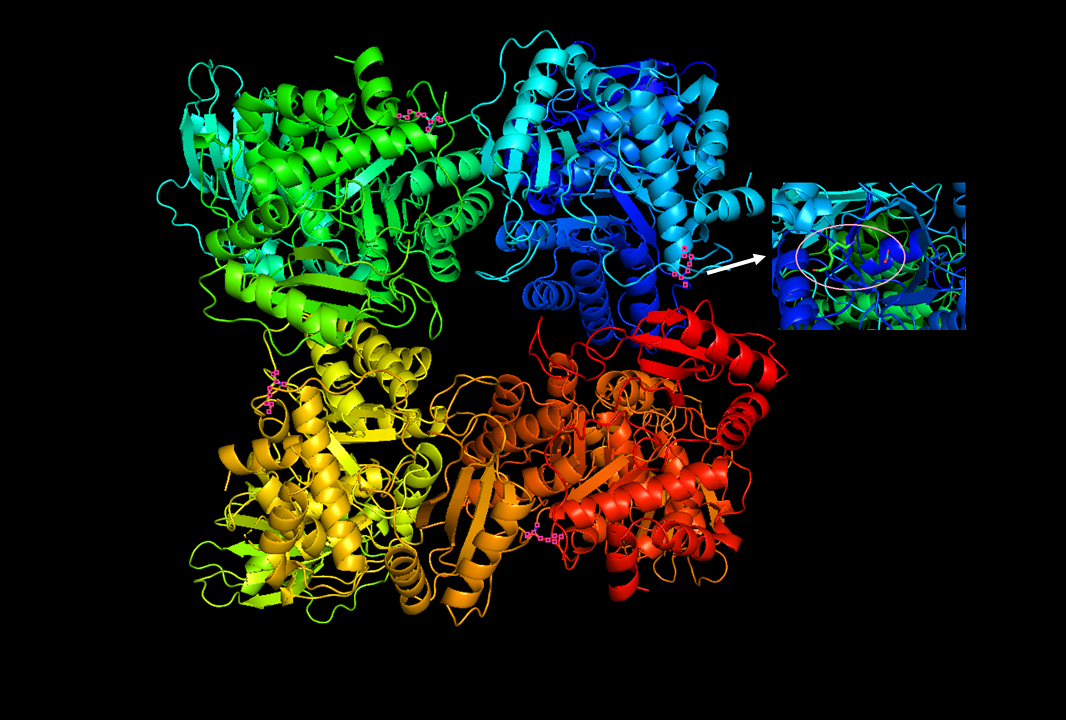 Evolution, of course, doesn't have an intelligent designer because it's a purely natural, non-sentient process involving nothing more that the operation of chemistry and physics in a selective environment. However, Creationists insist that nothing happens without god-magic and the involvement of a sentient directing entity, even though the existence of such an entity has never been demonstrated or explained, and there are no authenticated accounts of it ever making anything happen that couldn't have happened without it.
Evolution, of course, doesn't have an intelligent designer because it's a purely natural, non-sentient process involving nothing more that the operation of chemistry and physics in a selective environment. However, Creationists insist that nothing happens without god-magic and the involvement of a sentient directing entity, even though the existence of such an entity has never been demonstrated or explained, and there are no authenticated accounts of it ever making anything happen that couldn't have happened without it.
So, let’s look at the evolution of photosynthesis and especially the essential enzyme RuBisCo and the implications of recent research by a team from the Max-Planck-Institute for Terrestrial Microbiology in Marburg, Germany in collaboration with scientists from the University of Singapore.

A 3d cartoon depiction of the activated RuBisCO from spinach in open form with active site accessible. The active site Lys175 residues are marked in pink, and a close-up of the residue is provided to the right for one of the monomers composing the enzyme.
So, let’s look at the evolution of photosynthesis and especially the essential enzyme RuBisCo and the implications of recent research by a team from the Max-Planck-Institute for Terrestrial Microbiology in Marburg, Germany in collaboration with scientists from the University of Singapore.
Labels:
Botany
,
Creationism
,
Evolution
,
Nature
,
Science
,
Unintelligent Design
Wednesday 12 October 2022
A Creationist Nightmare Plant - Malevolent Design AND Evolution by Loss of Genes and Complexity

Geosiris australiensis
Source: Grey & Lee (2017)
Readers may remember how I recently described one of the most important symbiotic relationships on Earth - that between trees and fungi - as a classic example of how cooperation can evolve by the interaction of 'selfish' genes with other genes in their environment.
Creationists looking at that same relationship will insist that it is evidence of intelligent [sic] design, without ever providing evidence that such a designer entity has ever existed, any plausible mechanism by which it could have arisen without a designer, or a single, authenticated example of it ever having made chemistry and/or physics do something they couldn’t do without it.
Nevertheless, despite these shortcomings of their superstition, which means it isn't even a theory in the scientific sense, it satisfies their desire for easy answers, conforms with what their mummy and daddy believed, and avoids all that tiresome learning. Their conclusion is, therefore, that it must be true because it passes their "What do I want to be true?" test.
This article then will spoil that smugly self-satisfying conclusion on at least three counts:
- It shows any designer of this example to be a malevolent cheat who favours free-loading parasites.
- It involves evolution by loss of genes - something Creationist dogma claims is impossible in the erroneous belief that loss of information and loss of complexity are always deleterious, even though they are commonplace in successful parasites.
- It involves plate tectonics and an old Earth to explain how this example from Australia is related to species from Madagascar and the Comoro Islands.
Those Creationists who are afraid of even considering whether they could be wrong in case they upset an invisible, mind-reading, magic sky man, should probably stop reading now.
The following article by Elizabeth Joyce of James Cook University, Australia, reprinted from The Conversation under a Creative Commons license, reformatted for stylistic consistency, concerns a recently-discovered Australian parasitic plant that freeloads on the symbiotic relationship between fungi and plants by stealing the nutrients from the photosynthetic plant but giving nothing back. The original article can be read here:
Labels:
Biology
,
Botany
,
Evolution
,
Malevolent Design
,
Parasitism
,
Science
Saturday 8 October 2022
Biodiversity News - How Trees and Fungi Need Each Other and We Need Both
The ancient, intimate relationship between trees and fungi, from fairy toadstools to technicolour mushrooms
One of the most important symbiotic relationships on the planet is that between trees and fungi, without which we would have no trees, no forests, no timber, less oxygen and according to climatologists, very different weather patterns.
We would also not have all the species that depend on trees and forests which support one of the most diverse biota on the planet.
Trees themselves are an example of unintelligent design, as I explain in my book, The Unintelligent Designer: Refuting the Intelligent Design Hoax because their trunks and branches are the result of a massively wasteful arms race, as each tree competes with its neighbours to get its leaves above the canopy and into the sunlight. The result is a massive waste of energy and resource to build a structure which would have been unnecessary, had the ancestors of today's trees all being intelligently designed to stay at ground level and not compete for resources.
As a result of this unnecessary and wasteful complexity, another layer of complexity in the form of this symbiotic relationship between trees and fungi, which makes this possible, has evolved. Without it, trees could not obtain the nutrients they need or pump the water the leaves need to the top of the structure. So, from the perspective of the notion of intelligent [sic] design, we have massive waste and needless complexity to solve problems of the designer’s own incompetent making. So this relationship between fungi and trees represents one of the most glaring examples of the lack of foresight, planning and intelligence in whatever the design process behind it was.
From an evolutionary perspective, however, there is no need to explain bad design since there is no design process, as any intelligent person would understand it, involved. The result put the evolution of life on Earth on a trajectory that resulted in what we see today, and on which thousands of species are now dependent having evolved specialisations fitting them to live and survive in those niches by a process of co-evolving co-dependency - a predictable consequence of the process of evolution by natural selection.
The symbiotic relationship is between the roots of trees and the fungal hyphae in the soil, known as mycorrhizas. It is a lovely example of how Richard Dawkin's 'selfish genes' will form mutually beneficial alliances with the genomes of two or more organisms behaving like a single genome, albeit stored in different cells, co-evolving an every closer relationship, not of wasteful competition but of the more efficient cooperation, because cooperation benefits both organisms.
In another of the The Conversation series, 'Photos from the Field', Doctor Gregory Moore of The University of Melbourne and Associate Professor Mark Brundrett of the School of Biological Sciences, The University of Western Australia, explain this relationship, its evolutionary origins and why it is so important to the ecology of the planet. The open access article is reproduced here under a Creative Commons licence, reformatted for stylistic consistency. The original article can be read here:

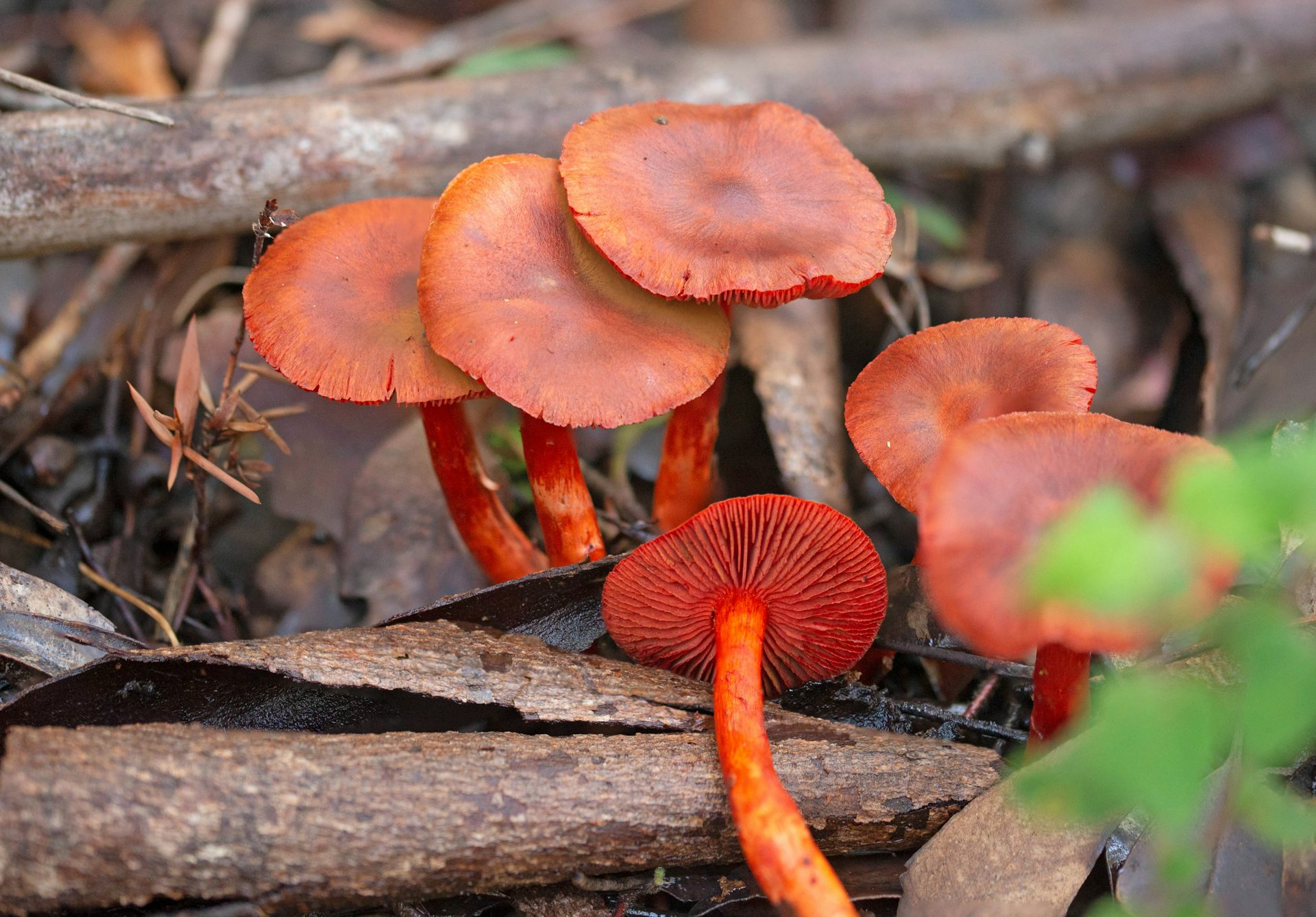 Gregory Moore, The University of Melbourne and Mark Brundrett, The University of Western Australia
Gregory Moore, The University of Melbourne and Mark Brundrett, The University of Western Australia
Environmental scientists see flora, fauna and phenomena the rest of us rarely do. In this series, we’ve invited them to share their unique photos from the field.
You may be familiar with the red toadstool with white spots, which are often the homes of fairies in children’s stories. These toadstools are also a small part of grander magical story: they are striking examples of mycorrhizas.
Mycorrhizas (pronounced my-cor-rye-zas) is the name for fungi associated with the root systems of many plants including trees, shrubs, groundcovers and grasses. These relationships are mutually symbiotic, which means both members benefit.
Fungi have a deeply ancient evolutionary origin, and colonised land with the first plants around 500 million years ago to form these partnerships. We humans often underestimate their importance to the ecosystems that have shaped life on earth.
So let’s take a closer look at how this relationship works and why it’s so important for Australian ecosystems.
An intimate relationship
Fungi come in a beautiful diversity of shapes, sizes and colours. The following photos by my co-author Mark Brundrett are just a few examples of those growing in southwest Australia.
Mycorrhizas are not to be confused with fungi that decompose dead plant matter (saprophytes) or those that cause disease (pathogens).
Saprophytes are fungi that recycle nutrients, and these can also be large and impressive. They can create tree hollows, which provide shelter for nesting birds and other animals such as possums.
The ethereal ghost fungus, for example, is a saprophyte. It famously glows green in the dark, and recycles nutrients in ecosystems by breaking down dead wood.
The primary role of mycorrhizas, on the other hand, is to provide resources such as phosphorus and nitrogen to flowering plants. They also effectively increase the absorptive surface area of the plant’s root system, allowing plants to take up much-needed water and nutrients so they grow better and more quickly.
In return, the plants provide carbohydrates, a product of photosynthesis, which mycorrhizas require to grow.
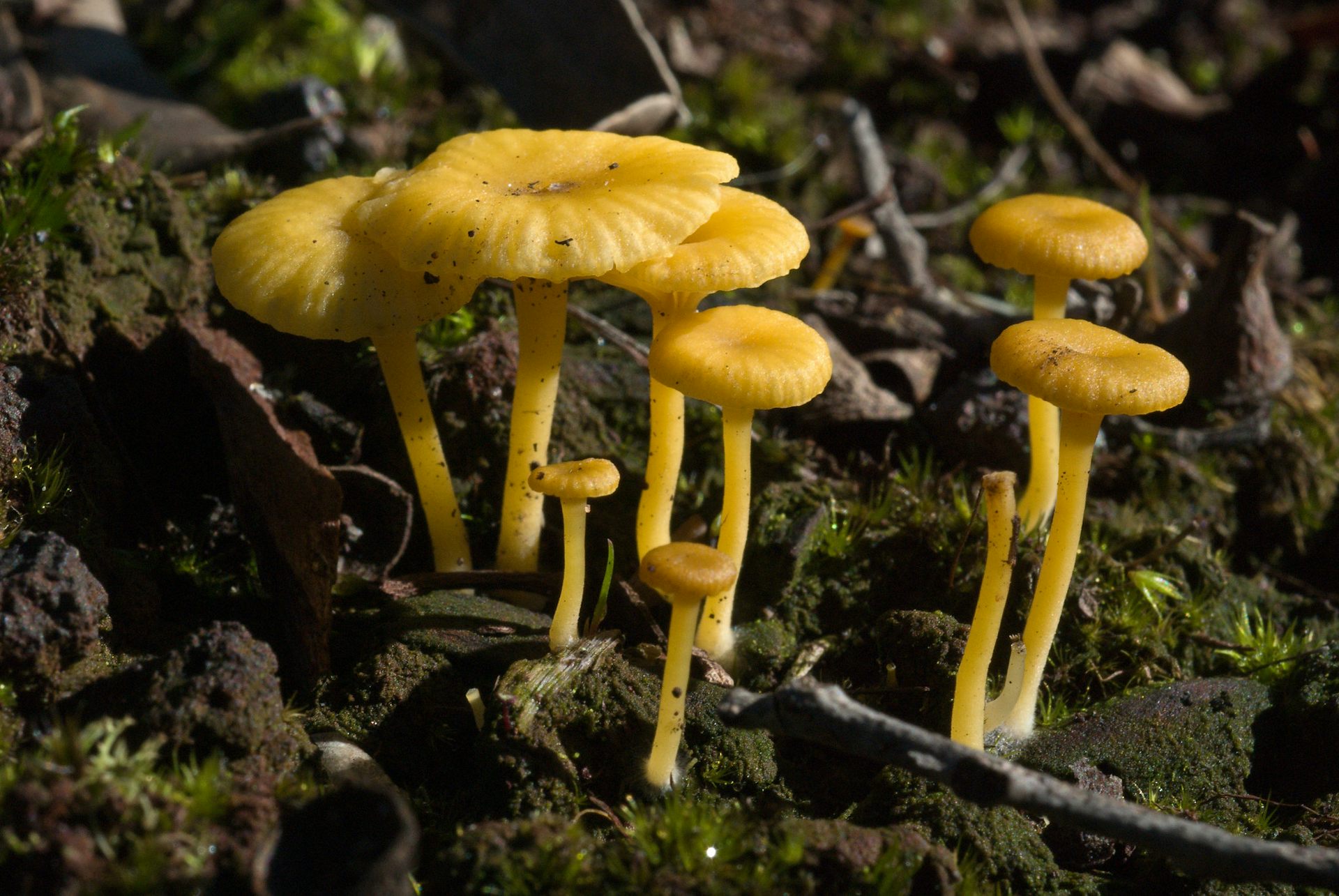
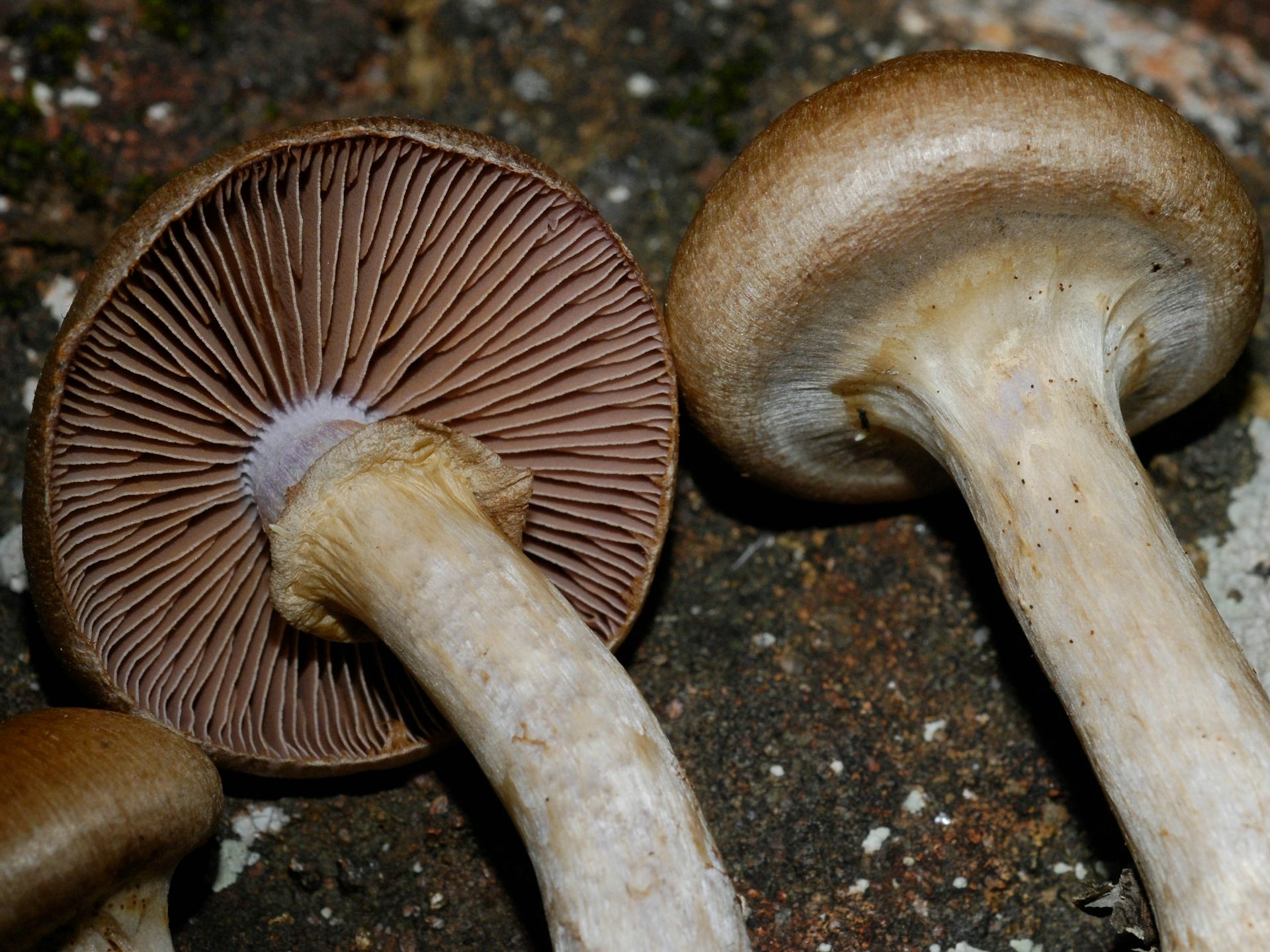
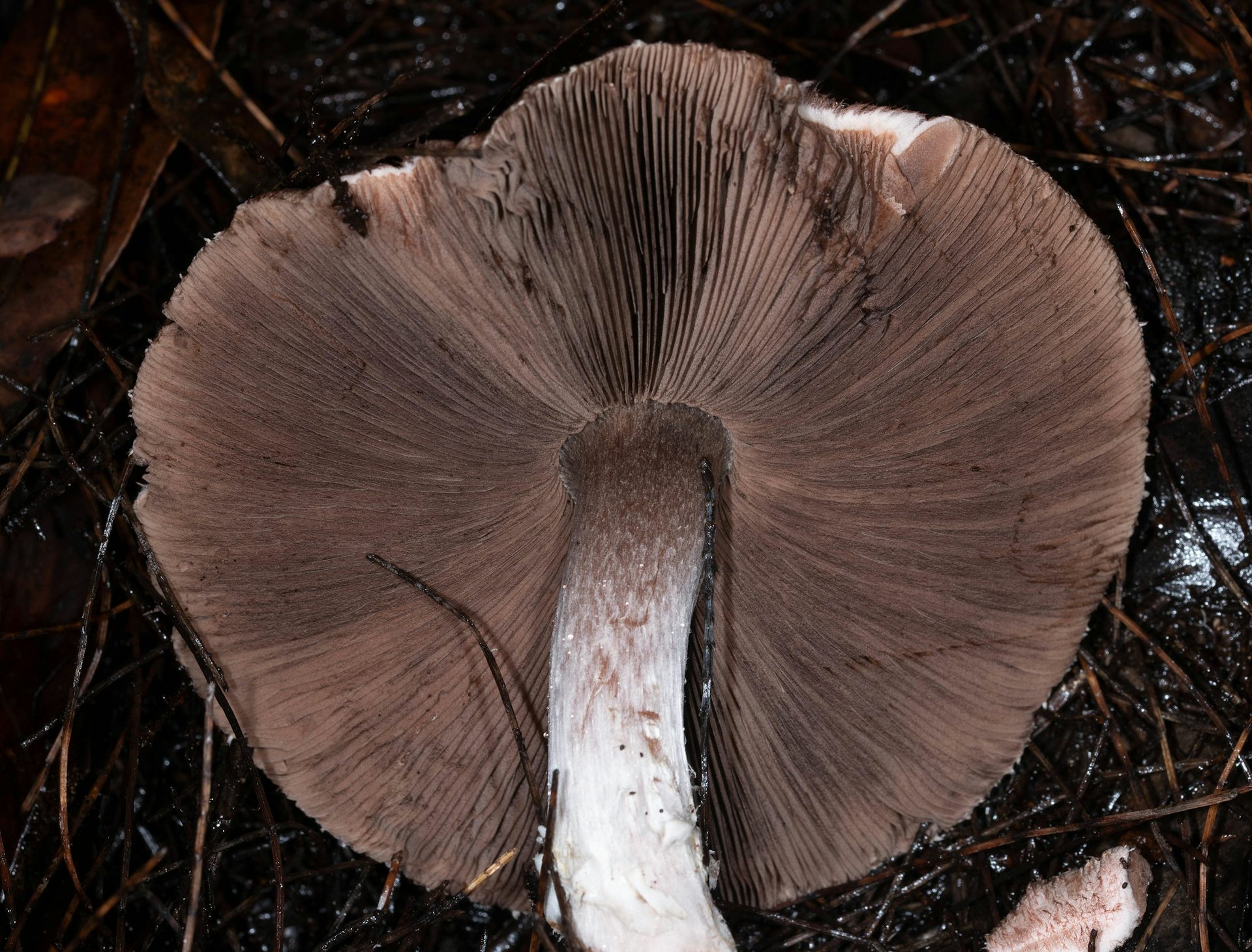 There are five different types of mycorrhizas, and two of these are particularly important in Australian ecosystems. One type is called “ectomycorrhiza”, where fungi wrap their hyphae (long, very fine hair-like structures that contact the soil) around the plant roots underground but don’t penetrate the root cells.
There are five different types of mycorrhizas, and two of these are particularly important in Australian ecosystems. One type is called “ectomycorrhiza”, where fungi wrap their hyphae (long, very fine hair-like structures that contact the soil) around the plant roots underground but don’t penetrate the root cells.
The other, called “endomycorrhiza”, is where fungi grow into the plant root, penetrating and branching within the root cells to form what look like little, microscopic trees. This is about as intimate a relationship between different types of organisms as you can get!

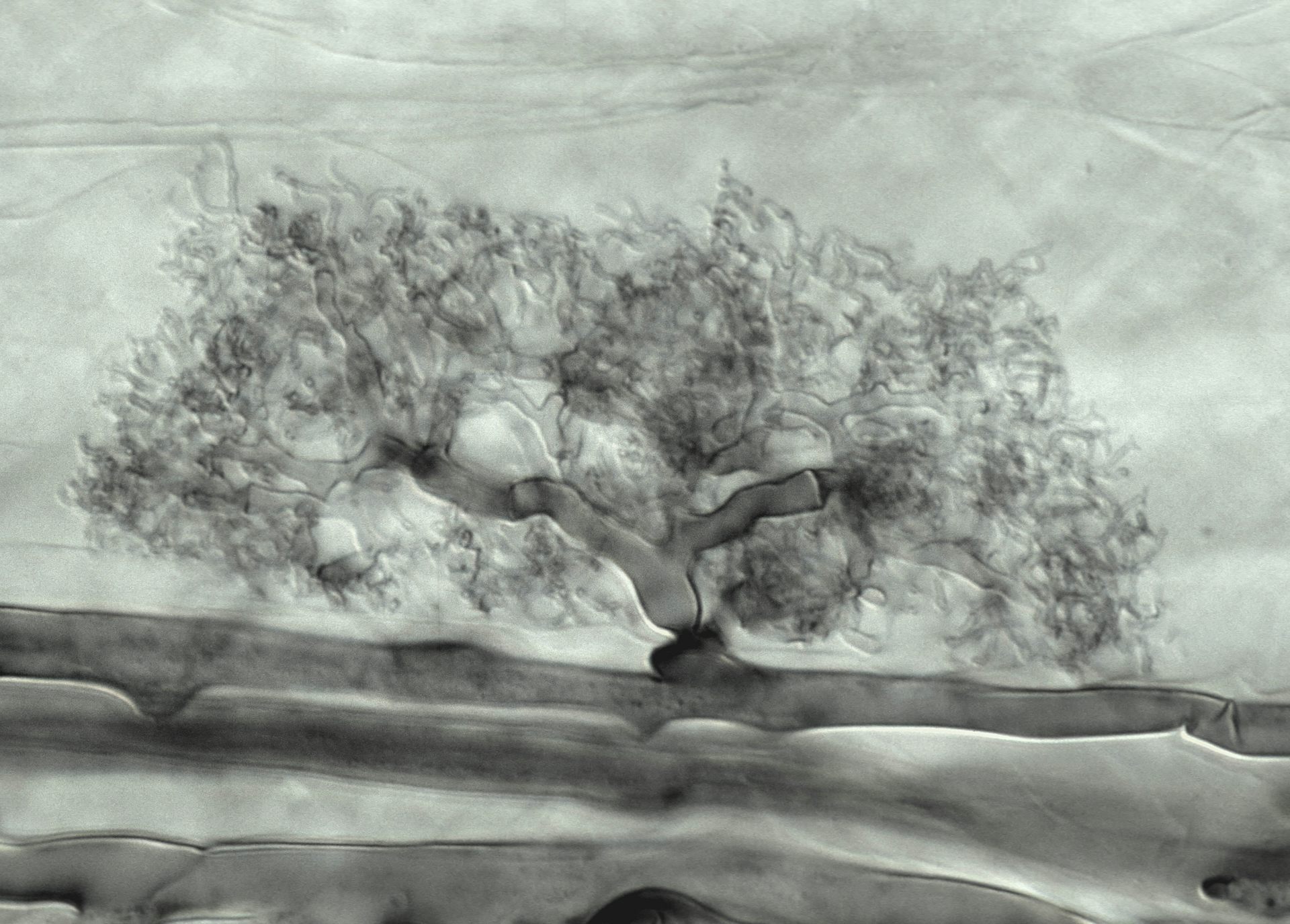 Mushrooms as big as dinner plates
Mushrooms as big as dinner plates
We often become aware of the presence of mycorrhizas only when conditions for reproduction are right, and a mushroom or toadstool emerges from the ground. Such conditions may only occur every five to ten years. For some species, there may be centuries between reproductive events.
For many of us, our experience with mycorrhizal fungi begins in very early childhood when we first catch sight of those spotty red and white toadstools, called the fly agaric or Amanita muscaria.
These fungi are often depicted in children’s book illustrations, such as Little Red Riding Hood, Jack and the Beanstalk, and a number of Enid Blyton’s tales. I recall conifers, such as pine trees, often growing nearby in the background of these pictures. This was no coincidence, Amanita muscaria forms mycorrhizal associations with many conifers, as well as oaks.
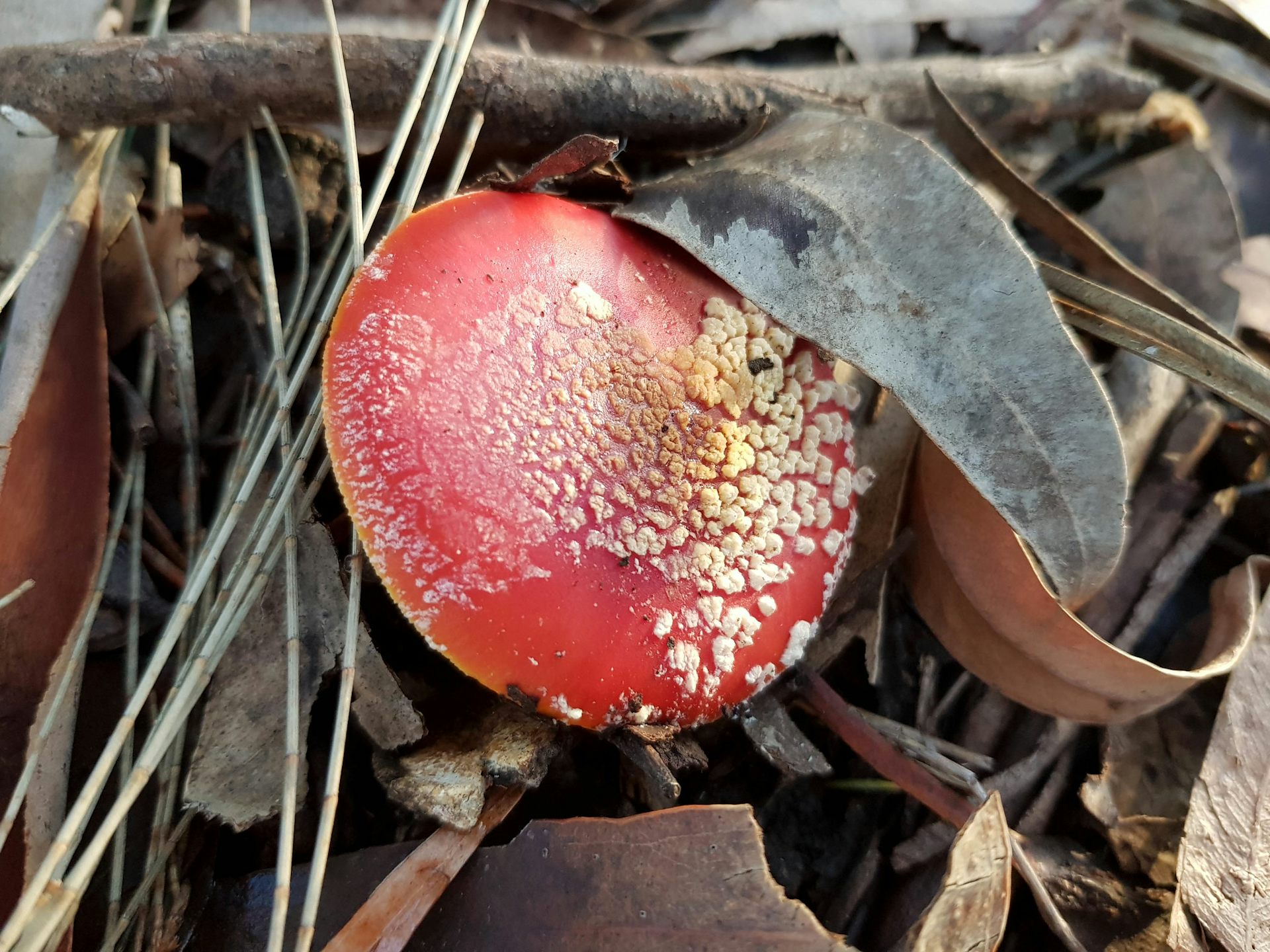
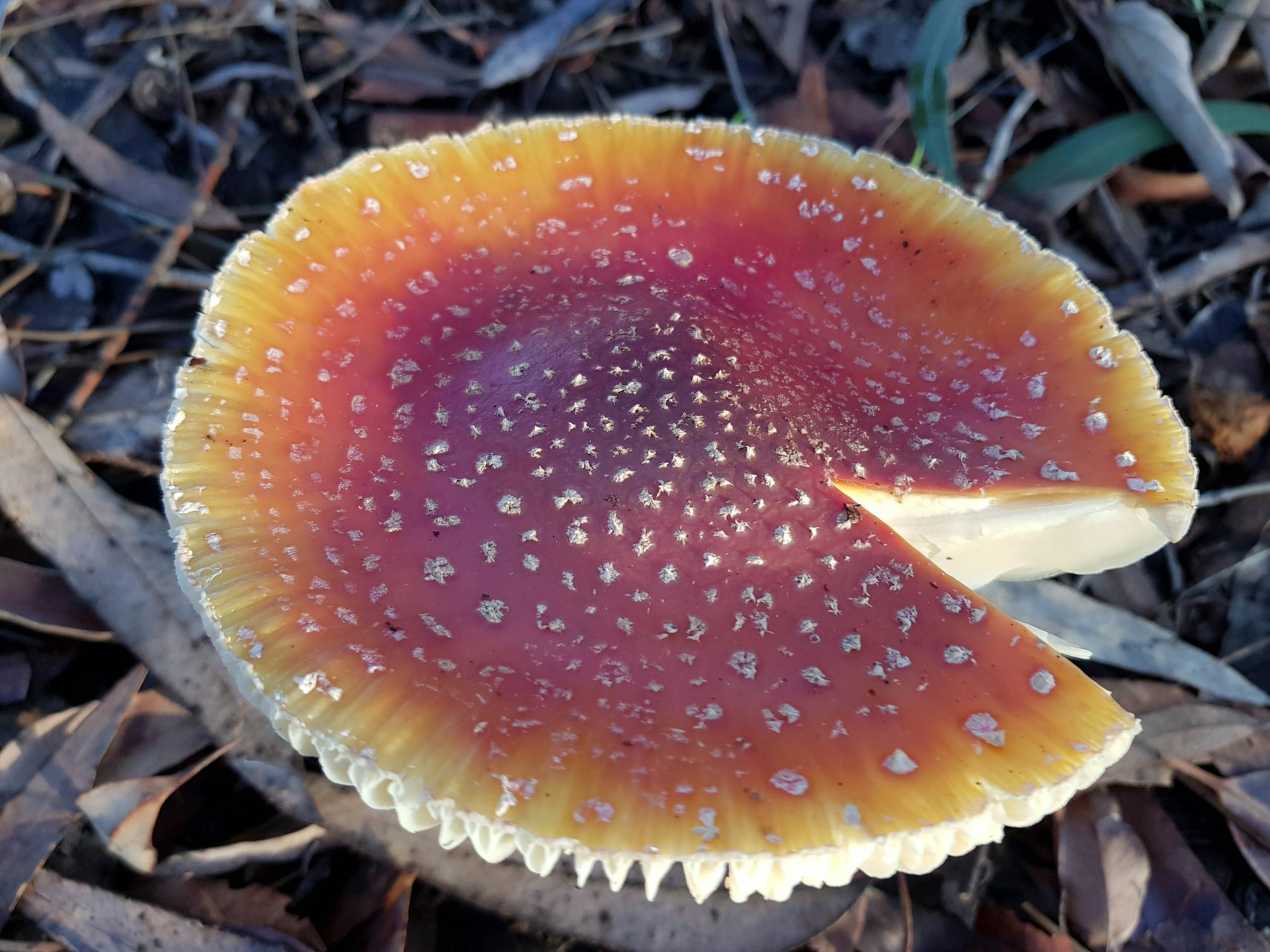 The mycorrhizal fungi associated with eucalypts can be less showy, with many being 75-100 millimetres across and a creamy, light tan in colour. They quite often pop up in home gardens, frequently in lawns, where they’re very obvious and usually within 4 to 5 metres of a tree trunk.
The mycorrhizal fungi associated with eucalypts can be less showy, with many being 75-100 millimetres across and a creamy, light tan in colour. They quite often pop up in home gardens, frequently in lawns, where they’re very obvious and usually within 4 to 5 metres of a tree trunk.
Others are spectacular, including the bright purple, orange or green Cortinarius species shown in the photos below. In fact, the beauty and diversity of our fungi now supports a new ecotourism industry in Australia, particularly in Tasmania.
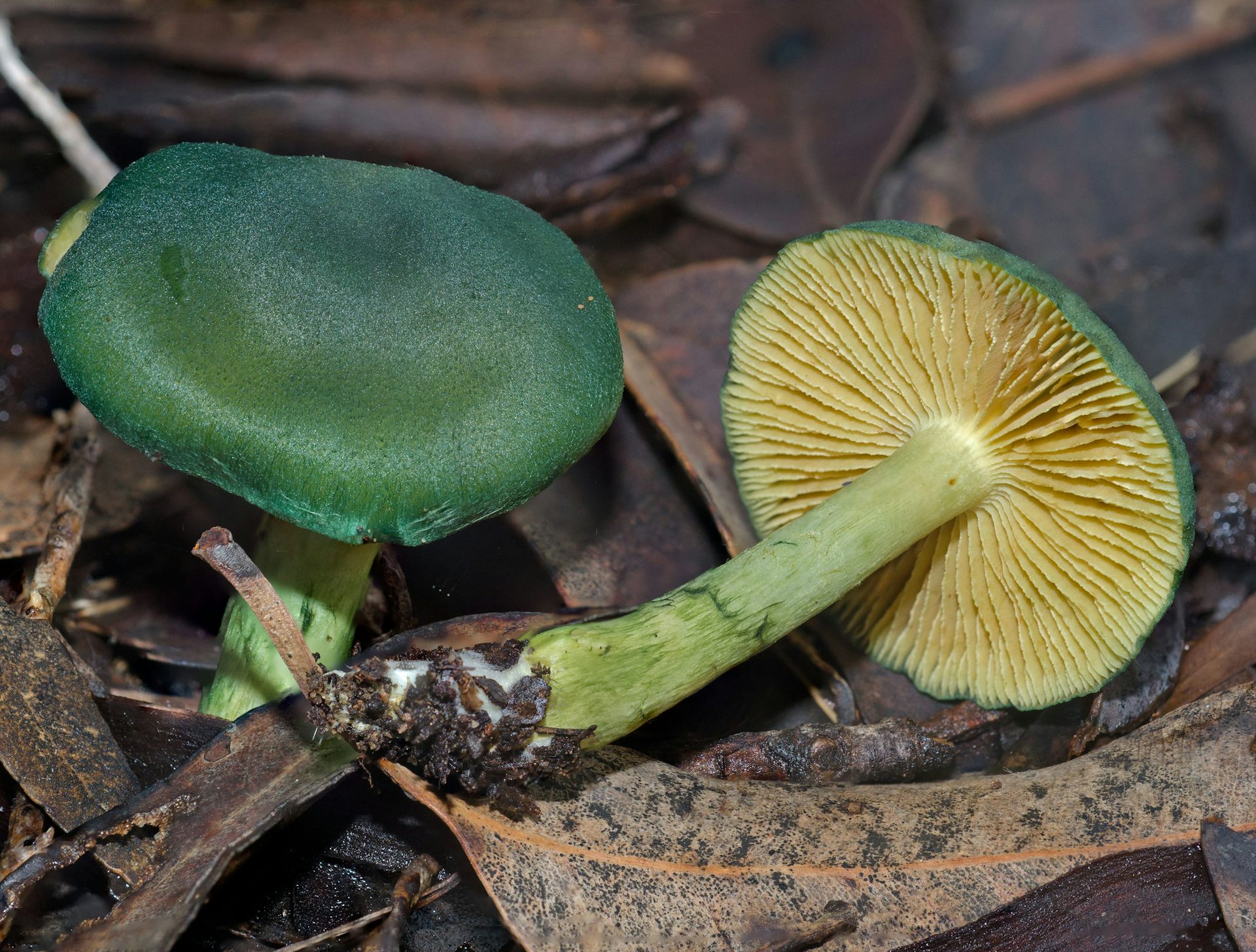
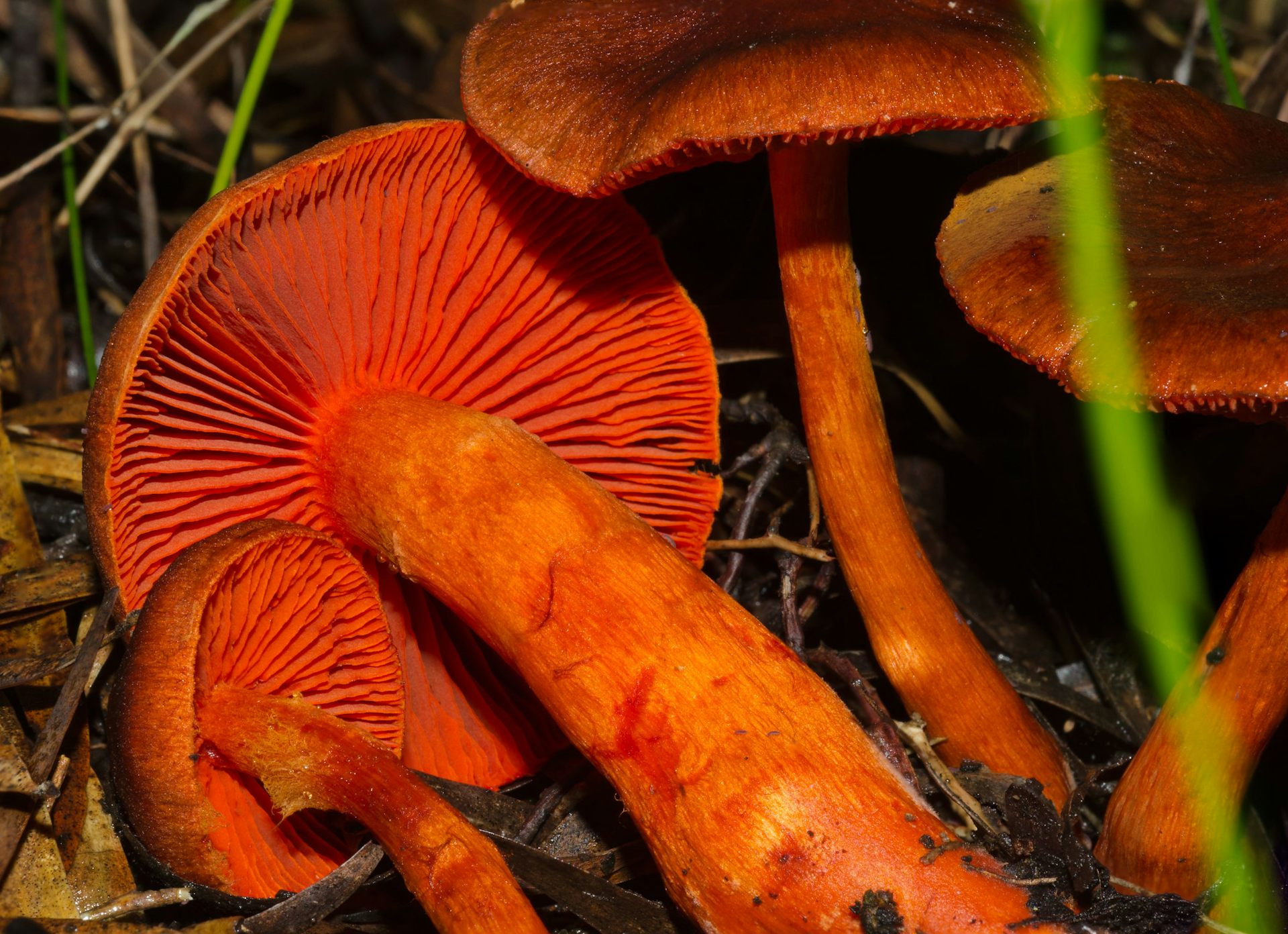
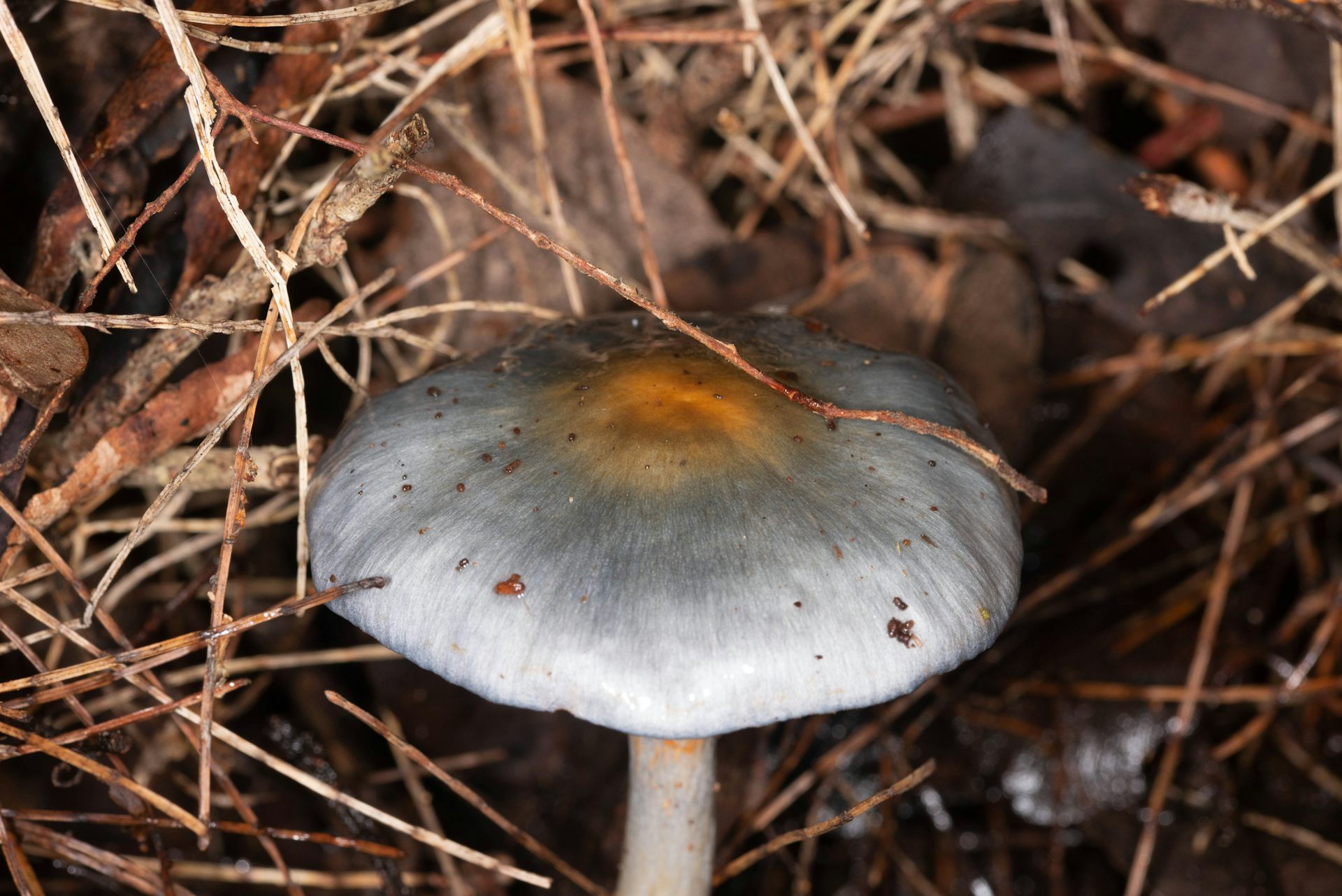 Some fungi are most impressive in the spring following bushfires, such as the abundant orange cup fungus shown below that stabilises ash beds.
Some fungi are most impressive in the spring following bushfires, such as the abundant orange cup fungus shown below that stabilises ash beds.
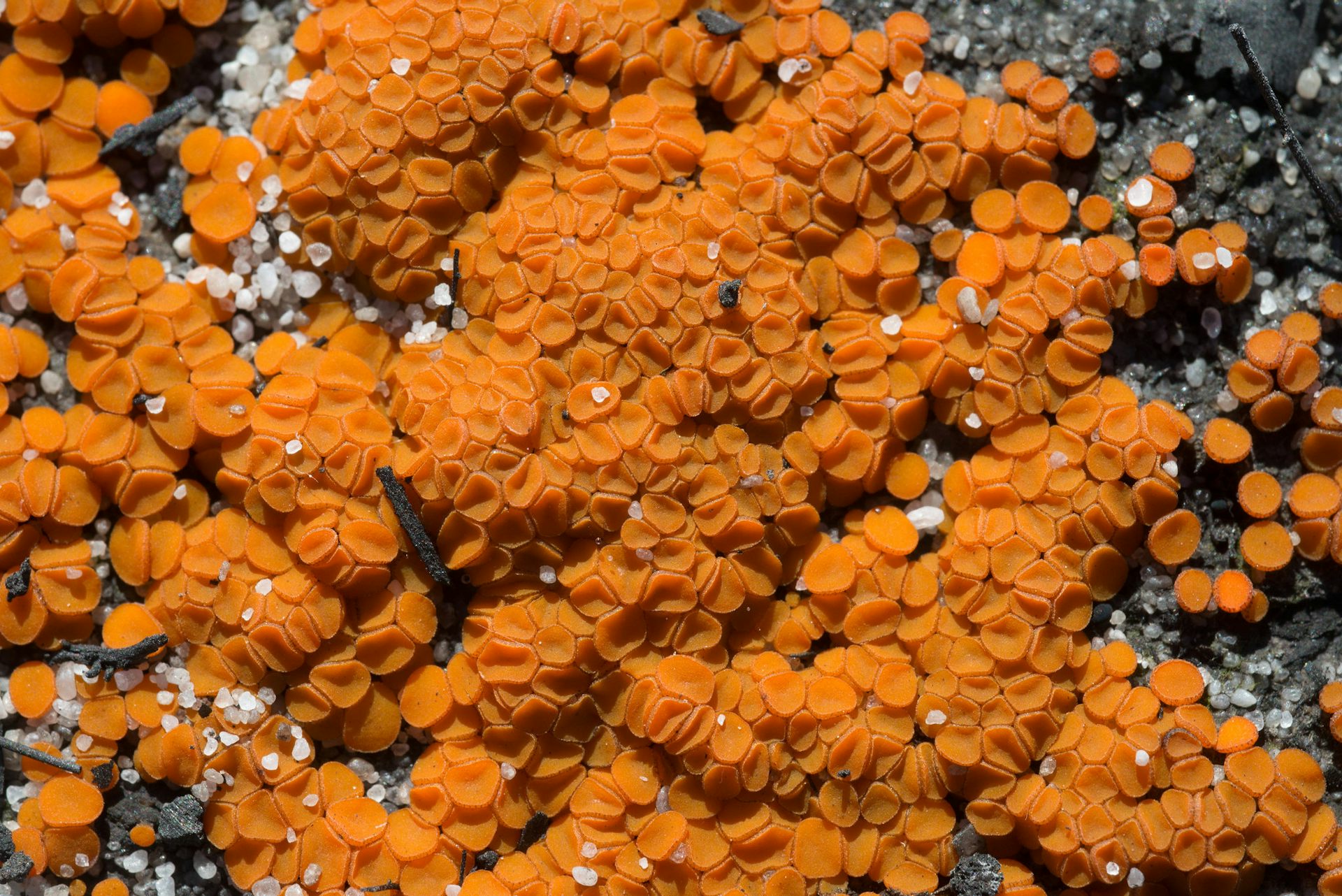 Indeed, most plants form mycorrhizal associations. Those that don’t include plants from the common vegetable families Brassicaceae (think broccoli, cauliflower, kale) and Chenopodiaceae (spinach, beetroot, and quinoa). Neither do members of the Proteaceae family, such as native banksias and grevilleas. These plants invest in very complex roots rather than fungal associations.
Indeed, most plants form mycorrhizal associations. Those that don’t include plants from the common vegetable families Brassicaceae (think broccoli, cauliflower, kale) and Chenopodiaceae (spinach, beetroot, and quinoa). Neither do members of the Proteaceae family, such as native banksias and grevilleas. These plants invest in very complex roots rather than fungal associations.
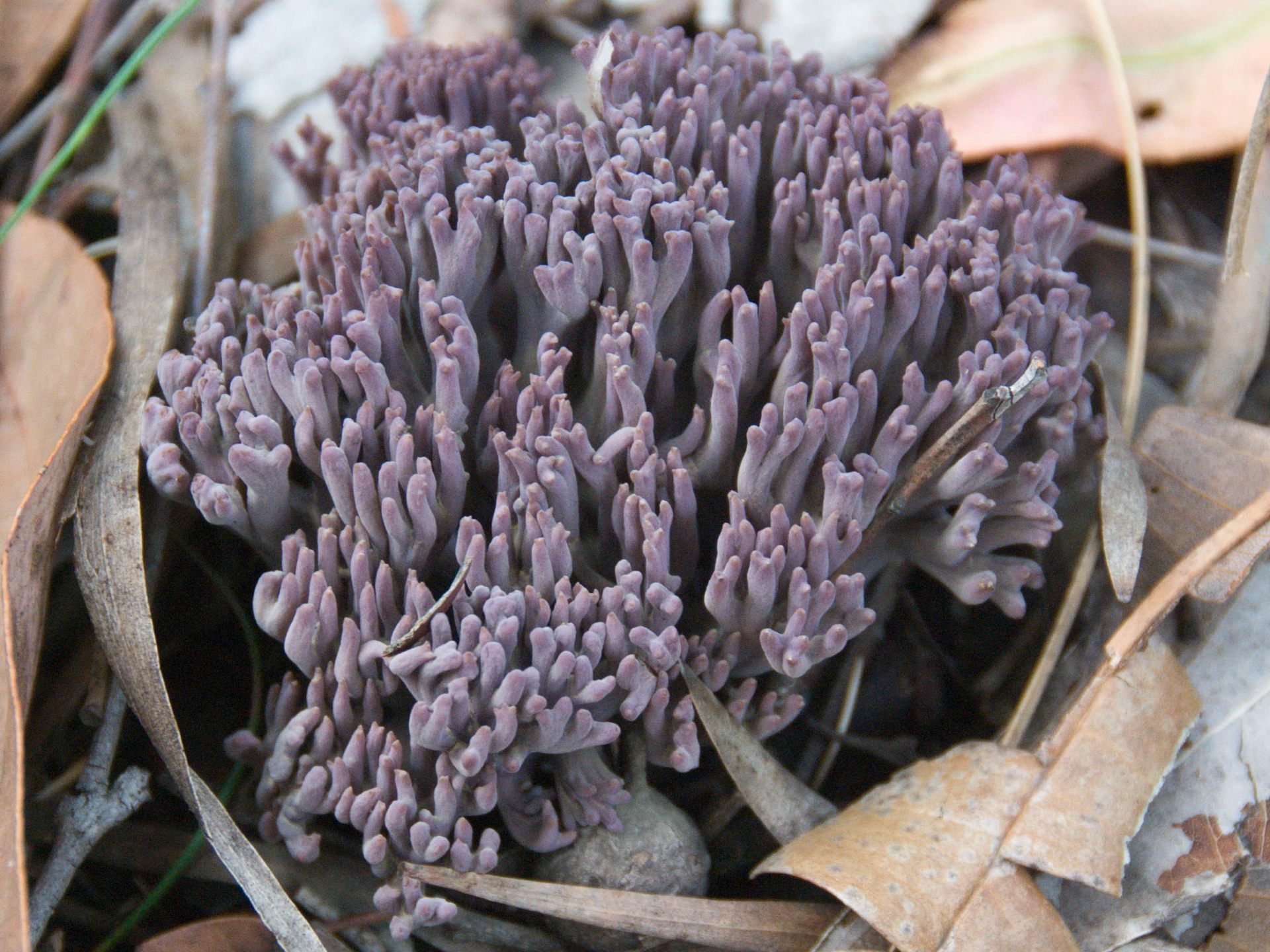
 Who’s really in control?
Who’s really in control?
Because we are so familiar with many of the plants in our environment, we are inclined to think it’s them that control their relationship with mycorrhizal fungi.
But it is possible mycorrhizal fungi exercise much more control. Or perhaps, the relationship is a perfect mutualistic symbiosis where partners share everything, including control, equally. We just don’t know yet.
Members of the fungus kingdom work in synchrony with the plant kingdom to support all terrestrial life, including animals such as ourselves. We may not think about fungi very often, but we cannot survive without them.
One of the surprise elements of Douglas Adam’s Hitchhiker’s Guide to the Galaxy, was that the Earth and its inhabitants existed as part of an experiment designed and controlled by white laboratory mice.
I sometimes wonder if the fate of the Earth’s terrestrial ecosystems rests on mycorrhizal fungi. If so, perhaps we need to show them greater respect.
 Gregory Moore, Doctor of Botany, The University of Melbourne and Mark Brundrett, Adjunct Associate Professor, School of Biological Sciences, The University of Western Australia
Gregory Moore, Doctor of Botany, The University of Melbourne and Mark Brundrett, Adjunct Associate Professor, School of Biological Sciences, The University of Western Australia
One of the most important symbiotic relationships on the planet is that between trees and fungi, without which we would have no trees, no forests, no timber, less oxygen and according to climatologists, very different weather patterns.
We would also not have all the species that depend on trees and forests which support one of the most diverse biota on the planet.
Trees themselves are an example of unintelligent design, as I explain in my book, The Unintelligent Designer: Refuting the Intelligent Design Hoax because their trunks and branches are the result of a massively wasteful arms race, as each tree competes with its neighbours to get its leaves above the canopy and into the sunlight. The result is a massive waste of energy and resource to build a structure which would have been unnecessary, had the ancestors of today's trees all being intelligently designed to stay at ground level and not compete for resources.
As a result of this unnecessary and wasteful complexity, another layer of complexity in the form of this symbiotic relationship between trees and fungi, which makes this possible, has evolved. Without it, trees could not obtain the nutrients they need or pump the water the leaves need to the top of the structure. So, from the perspective of the notion of intelligent [sic] design, we have massive waste and needless complexity to solve problems of the designer’s own incompetent making. So this relationship between fungi and trees represents one of the most glaring examples of the lack of foresight, planning and intelligence in whatever the design process behind it was.
From an evolutionary perspective, however, there is no need to explain bad design since there is no design process, as any intelligent person would understand it, involved. The result put the evolution of life on Earth on a trajectory that resulted in what we see today, and on which thousands of species are now dependent having evolved specialisations fitting them to live and survive in those niches by a process of co-evolving co-dependency - a predictable consequence of the process of evolution by natural selection.
The symbiotic relationship is between the roots of trees and the fungal hyphae in the soil, known as mycorrhizas. It is a lovely example of how Richard Dawkin's 'selfish genes' will form mutually beneficial alliances with the genomes of two or more organisms behaving like a single genome, albeit stored in different cells, co-evolving an every closer relationship, not of wasteful competition but of the more efficient cooperation, because cooperation benefits both organisms.
In another of the The Conversation series, 'Photos from the Field', Doctor Gregory Moore of The University of Melbourne and Associate Professor Mark Brundrett of the School of Biological Sciences, The University of Western Australia, explain this relationship, its evolutionary origins and why it is so important to the ecology of the planet. The open access article is reproduced here under a Creative Commons licence, reformatted for stylistic consistency. The original article can be read here:

The ancient, intimate relationship between trees and fungi, from fairy toadstools to technicolour mushrooms

Cortinarius kula
Credit: Mark Brundrett, Author provided
Environmental scientists see flora, fauna and phenomena the rest of us rarely do. In this series, we’ve invited them to share their unique photos from the field.
You may be familiar with the red toadstool with white spots, which are often the homes of fairies in children’s stories. These toadstools are also a small part of grander magical story: they are striking examples of mycorrhizas.
Mycorrhizas (pronounced my-cor-rye-zas) is the name for fungi associated with the root systems of many plants including trees, shrubs, groundcovers and grasses. These relationships are mutually symbiotic, which means both members benefit.
Fungi have a deeply ancient evolutionary origin, and colonised land with the first plants around 500 million years ago to form these partnerships. We humans often underestimate their importance to the ecosystems that have shaped life on earth.
So let’s take a closer look at how this relationship works and why it’s so important for Australian ecosystems.
An intimate relationship
Fungi come in a beautiful diversity of shapes, sizes and colours. The following photos by my co-author Mark Brundrett are just a few examples of those growing in southwest Australia.
Mycorrhizas are not to be confused with fungi that decompose dead plant matter (saprophytes) or those that cause disease (pathogens).
Saprophytes are fungi that recycle nutrients, and these can also be large and impressive. They can create tree hollows, which provide shelter for nesting birds and other animals such as possums.
The ethereal ghost fungus, for example, is a saprophyte. It famously glows green in the dark, and recycles nutrients in ecosystems by breaking down dead wood.
The primary role of mycorrhizas, on the other hand, is to provide resources such as phosphorus and nitrogen to flowering plants. They also effectively increase the absorptive surface area of the plant’s root system, allowing plants to take up much-needed water and nutrients so they grow better and more quickly.
In return, the plants provide carbohydrates, a product of photosynthesis, which mycorrhizas require to grow.

The yellow navel fungus Lichenomphalia chromacea forms a protective crust on soils in association with lichen fungi and algae.
Credit: Mark Brundrett, Author provided

Cortinarius vinaceolamellatus is a beautiful fungus that supports the growth of of tall eucalyptus forests.
Credit: Mark Brundrett, Author provided

This saprophyte is a relative of the common mushroom sold in shops (a species of Agaricus). Australian fungi can be toxic so leave them where they grow.
Credit: Mark Brundrett, Author provided
The other, called “endomycorrhiza”, is where fungi grow into the plant root, penetrating and branching within the root cells to form what look like little, microscopic trees. This is about as intimate a relationship between different types of organisms as you can get!

Microscopic cross-sectional view of an ectomycorrhizal pine tree root about 0.5 millimetres wide. This revels a labyrinth of black stained fungus hyphae surrounding root cells to form a nutrient exchange zone.
Credit: Mark Brundrett, Author provided

Arbuscular mycorrhizas are tiny tree-like growths inside the root cell where materials are exchanged with the host plant.
Credit: Mark Brundrett, Author provided
We often become aware of the presence of mycorrhizas only when conditions for reproduction are right, and a mushroom or toadstool emerges from the ground. Such conditions may only occur every five to ten years. For some species, there may be centuries between reproductive events.
For many of us, our experience with mycorrhizal fungi begins in very early childhood when we first catch sight of those spotty red and white toadstools, called the fly agaric or Amanita muscaria.
These fungi are often depicted in children’s book illustrations, such as Little Red Riding Hood, Jack and the Beanstalk, and a number of Enid Blyton’s tales. I recall conifers, such as pine trees, often growing nearby in the background of these pictures. This was no coincidence, Amanita muscaria forms mycorrhizal associations with many conifers, as well as oaks.

The fly agaric or Amanita muscaria is a striking fungus often seen in children’s books.
Credit: Mark Brundrett, Author provided

The fame of Amanita muscaria also arises from the hallucinogenic properties it sometimes has, but this fungus is most likely to have toxic consequences for those who eat it. It was also used as a natural insect killer.
Credit: Mark Brundrett, Author provided
Others are spectacular, including the bright purple, orange or green Cortinarius species shown in the photos below. In fact, the beauty and diversity of our fungi now supports a new ecotourism industry in Australia, particularly in Tasmania.

The bright green mushroom Cortinarius austroveneta is found in tall eucalypt forests.
Credit: Mark Brundrett, Author provided

Cortinarius erythrocephalus is another brilliantly coloured mycorrhizal forest mushroom.
Credit: Mark Brundrett, Author provided

Cortinarius rotundisporus, also known as the elegant blue webcap, can be found in southern Australia.
Credit: Mark Brundrett, Author provided

The orange cup fungus Anthrocobya muelleri is found briefly after severe fires.
Credit: Mark Brundrett, Author provided

This is a species of Ramaria, a mycorrhizal genus comprising approximately 200 species of coral fungi.
Credit: Mark Brundrett

Phlebopus marginatus is possibly Australia’s largest terrestrial mushroom, with one found in Victoria weighing in at 29 kilograms.
Credit: Mark Brundrett, Author provided
Because we are so familiar with many of the plants in our environment, we are inclined to think it’s them that control their relationship with mycorrhizal fungi.
But it is possible mycorrhizal fungi exercise much more control. Or perhaps, the relationship is a perfect mutualistic symbiosis where partners share everything, including control, equally. We just don’t know yet.
Members of the fungus kingdom work in synchrony with the plant kingdom to support all terrestrial life, including animals such as ourselves. We may not think about fungi very often, but we cannot survive without them.
One of the surprise elements of Douglas Adam’s Hitchhiker’s Guide to the Galaxy, was that the Earth and its inhabitants existed as part of an experiment designed and controlled by white laboratory mice.
I sometimes wonder if the fate of the Earth’s terrestrial ecosystems rests on mycorrhizal fungi. If so, perhaps we need to show them greater respect.
Thursday 1 September 2022
How Science Works - Changing Our Minds When the Evidence Changes
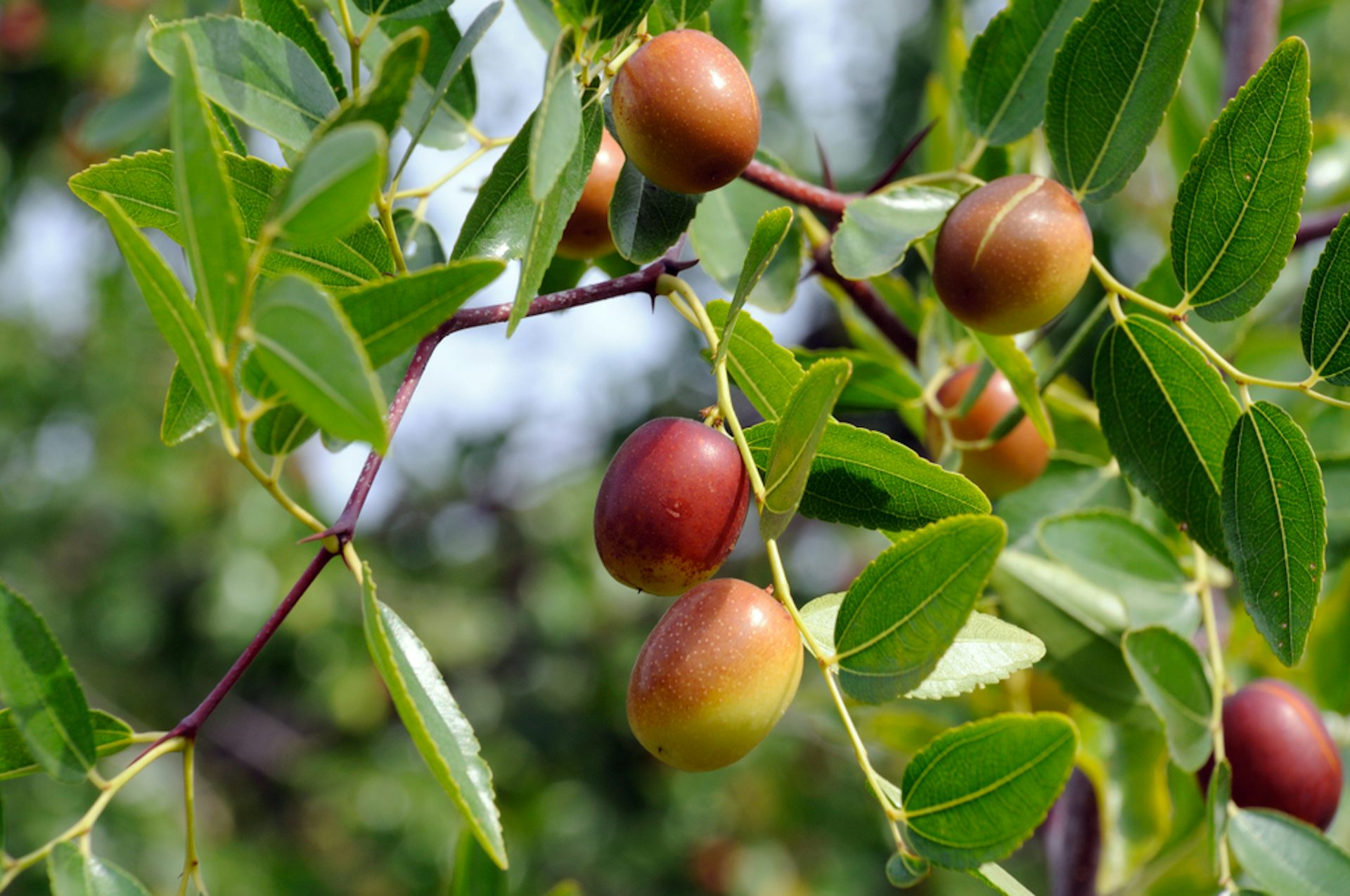
Jujube, Ziziphus jujuba.
Source: Alex___photo/Shutterstock
Although Creationists seem to be baffled by the concept of uncertainty and the idea that knowledge can only ever be provisional, in fact, this is what gives science it's great power. By contrast, religions, which depend on certainty in the face of a lack of evidence and where a 'crisis of faith', i.e., doubt due to an unwelcome intrusion of reality, is considered a bad thing, are still mired in the Bronze Age when the basic ideas were first codified by people who knew little but sought certainty in a confusing and frightening, seemingly magical world, so made some best guesses with what little knowledge they had.
So, it's never surprising and always reassuring when another science paper is published showing that the scientific consensus was wrong about something. Unlike with black and white Creationists thinking, right and wrong are not absolute terms in science. Scientific ideas can be mostly right but not absolutely right since there are no absolutes where there is uncertainty and without uncertainty there is no scientific progress. Rather, science is a self-correcting, ever improving search for the truth as revealed by evidence.
As we say, science is reasonable uncertainty, whereas religion is unreasonable certainty.
Labels:
Botany
,
Creationism
,
Evolution
,
Science
Wednesday 31 August 2022
Evolution News - How the Evolution of Land Plants Changed Earth's Environment.
Land plants changed Earth’s composition, say scientists | University of Southampton
Another piece of the story of how Earth came to be the way is today has been revealed by an international team of scientists led by led by Dr Christopher Spencer of Queen’s University, Kingston, Ontario, Canada, and including researchers at the University of Southampton, Hampshire, UK, the University of Cambridge, Cambridgeshire, UK and the University of Geosciences, Wuhan, China.
They have shown how the evolution of land plants changed Earth's environment, paving the way for the eventual evolution of dinosaurs, 200 million years later, followed by birds and mammals and the diversity of vertebrates we see today.
And of course, it is entirely at odds with the account in the Bible which Creationists have been fooled into thinking is the way it happened. Obviously, magic was not involved anywhere in the process
Another piece of the story of how Earth came to be the way is today has been revealed by an international team of scientists led by led by Dr Christopher Spencer of Queen’s University, Kingston, Ontario, Canada, and including researchers at the University of Southampton, Hampshire, UK, the University of Cambridge, Cambridgeshire, UK and the University of Geosciences, Wuhan, China.
They have shown how the evolution of land plants changed Earth's environment, paving the way for the eventual evolution of dinosaurs, 200 million years later, followed by birds and mammals and the diversity of vertebrates we see today.
And of course, it is entirely at odds with the account in the Bible which Creationists have been fooled into thinking is the way it happened. Obviously, magic was not involved anywhere in the process
Labels:
Botany
,
Creationism
,
Evolution
,
Geology
,
Science
Monday 1 August 2022
Evolution News - A Beautiful Example of Co-Evolution
Orchid helps insect get a grip | Research at Kobe
The explanatory power of the Theory of Evolution was demonstrated yet again recently, when five biologists from Japan published a paper in the journal Ecology in which they explained what had been a mystery in the form of a peculiarly shaped orchid flower, the so-called white egret orchid, Habenaria radiata syn. Pecteilis radiata, or sagisō, native to China, Korea and Japan, which has a superficial resemblance to a flying Egret.
The mystery had been the reason for the bizarre, jagged edge to two of the three petals of the flower. Orchids are well known for their adaptation to pollination by specific species of insects, notably bees and moths and for their part in co-evolutionary, co-dependent relationships, often with a single species.
The explanatory power of the Theory of Evolution was demonstrated yet again recently, when five biologists from Japan published a paper in the journal Ecology in which they explained what had been a mystery in the form of a peculiarly shaped orchid flower, the so-called white egret orchid, Habenaria radiata syn. Pecteilis radiata, or sagisō, native to China, Korea and Japan, which has a superficial resemblance to a flying Egret.
The mystery had been the reason for the bizarre, jagged edge to two of the three petals of the flower. Orchids are well known for their adaptation to pollination by specific species of insects, notably bees and moths and for their part in co-evolutionary, co-dependent relationships, often with a single species.
Tuesday 19 July 2022
Evolution News - How the Environment Drives Evolution
Plant study hints evolution may be predictable | YaleNews
 On of the enduring debates in biology is to what extent evolution is predictable. If we could somehow rewind the tape and play it again, would we end up with the same species as we have today, or would the result be a very different planet with different taxons and different dominant species? Would it in fact produce an intelligent species capable of going to the moon and building computers?
On of the enduring debates in biology is to what extent evolution is predictable. If we could somehow rewind the tape and play it again, would we end up with the same species as we have today, or would the result be a very different planet with different taxons and different dominant species? Would it in fact produce an intelligent species capable of going to the moon and building computers?
The problem is that the environment, which is the underlying driver of evolution, is itself subject to unpredictable changes and the operation of chaos, where a small change here or there can have a large effect some way down the line - the proverbial butterfly effect where a butterfly flapping its wings on a Pacific island can result in a hurricane in the Himalayas. Small, randon fluctuations in weather patterns or ocean currents can have widespread effects on the distribution of different species in food chains, for example.
This piece of research, although interesting in that it shows the effect of the environment as a driver of evolution, doesn't really answer that question because it shows what can happen when the environment is a constant. This is, of course, the prerequisite for convergent evolution, where, not surprisingly, from a similar starting point, in a given environment, evolutions tends to home in on the same phenotypic solutions, albeit by different genetic routes.
As explained in a Yale News article by Bill Hathaway:

Similar leaf types evolved independently in three species of plants found in cloud forests of Oaxaca, Mexico and three species of plants in similar environment in Chiapas, Mexico. This example of parallel evolution is one of several found by Yale-led scientists and suggests that evolution may be predictable.
The problem is that the environment, which is the underlying driver of evolution, is itself subject to unpredictable changes and the operation of chaos, where a small change here or there can have a large effect some way down the line - the proverbial butterfly effect where a butterfly flapping its wings on a Pacific island can result in a hurricane in the Himalayas. Small, randon fluctuations in weather patterns or ocean currents can have widespread effects on the distribution of different species in food chains, for example.
This piece of research, although interesting in that it shows the effect of the environment as a driver of evolution, doesn't really answer that question because it shows what can happen when the environment is a constant. This is, of course, the prerequisite for convergent evolution, where, not surprisingly, from a similar starting point, in a given environment, evolutions tends to home in on the same phenotypic solutions, albeit by different genetic routes.
As explained in a Yale News article by Bill Hathaway:
Tuesday 21 June 2022
Evolution News - How Plants Colonised the Land.

The diversity of flora and fauna as we know them today and the substrate on which thrive are thanks to a single species of algae that first went ashore more than 500 million years ago. This and all other drawings in the publication are by the paper’s first author, Dr. Mona Schreiber.
Image: HHU /Dr Mona Schreiber
A team led by evolutionary biologist Prof. Dr. Sven Gould of Heinrich Heine University Düsseldorf (HHU) has been studying the current state of research on the plant colonisation of land that occurred some 500 million years ago. The findings from this illustrated overview study published by Dr. Mona Schreiber as lead author have now appeared, open access, in the latest issue of the journal Trends in Plant Science.
It was to take several hundred million years for Earth to cool sufficiently for oceans and landmasses to form then the conditions on land were far from conducive to the life that was evolving in the oceans to begin to colonise that land. Until about 500 million years ago, seismic activity meant the atmosphere was toxic and a weaker magnetic field meant UV light was more intensive. Then things began to change, and all terrestrial plant life has developed from the first plant species, a streptophyte alga, that began to move out of the oceans onto land. This was followed by simple animal life which in turn created the opportunities for tetraploid vertebrates to exploit by coming onto the land, developing air-breathing and a tetrapodal lifestyle.
The Heinrich Heine Universität news release explains:
Wednesday 11 May 2022
Unintelligent Designer News - More on the Blunder That is RuBisCo

The enzyme rubisco is found in all plants and other photosynthesizing organisms. It plays a key role in fixing carbon from the air and has helped shape life on Earth.
Credit: Getty Images
Readers may recall how I wrote recently about the enzyme RuBisCo, and how, if they understood its significance, it would be a major embarrassment for devotees of creationism's putative intelligent [sic] designer. To give it it's full chemical name, ribulose-1,5-bisphosphate carboxylase/oxygenase is probably the least efficient enzyme in all biology and yet is absolutely essential for the energy almost all living things ultimately depend on.
It is responsible for 'fixing' the inorganic carbon in atmospheric carbon dioxide (CO2) as the first stage in building the carbon chain that is the backbone of the organic sugar, glucose, which is the end product of photosynthesis, along with free Oxygen (O2) as a by-product.
Indeed, so inefficient is RuBisCo that it is the reason there is so much green in the world, wherever there are growing plants. RuBisCo manages about 4 reactions a second against the hundreds or thousands of reactions that most other enzymes are capable of, and, because it frequently mistakes a molecule of O2 for one of CO2, it frequently wrecks the process and causes a loss of carbon. It can also go wrong and produce xylulose-1,5-bisphosphate which actually poisons it!
Because of this inefficiency, there is great pressure on scientists to come up with an alternative, or to develop an improved version, in order to increase food production, and, to that end, multiple universities and research institutes have established the RIPE Project, led by the University of Illinois, USA in partnership with The Australian National University, Chinese Academy of Sciences, Commonwealth Scientific and Industrial Research Organisation, Lancaster University, UK, Louisiana State University, USA, University of California, Berkeley, USA, University of Cambridge, UK, University of Essex, UK, and U.S. Department of Agriculture, Agricultural Research Service.
But one of the programs run by RIPE has just reported a failure. The researchers at the Division of Plant Sciences, Research School of Biology, The Australian National University, Acton, ACT, Australia, had been hoped that, if they could improve the supply of CO2 to RuBisCo, they could improve its efficiency. However, they discovered that the limitation was not the availability of CO2 itself but the ability of RuBisCo to utilise it that was the bottleneck in the process.
As the RIPE news release explains:
Labels:
Biology
,
Botany
,
Creationism
,
Evolution
,
Science
Friday 11 February 2022
Missing Link News - A Triple Whammy for Half-Baked Creationists. How Sweet!
Mystery of sweetpotato origin uncovered, as missing link plant found by Oxford research | University of Oxford
Here is one of those scientific discoveries that should have every Creationist covering their eyes and ears and looking the other way, or simply invoking some wackadoodle conspiracy theory in order to dismiss it. What they won't do, is incorporate the new knowledge and adjust their opinion accordingly.
Their problem is because the discovery shatters three of their most cherished dogmas:
The problem was that the sweetpotato is a hexaploid plant, having six copies of each chromosome, instead of the usual two, in other words, its entire genome has been trebled. Polyploidy is common in plants and is a common way new species arise because a polyploid individual cannot normally interbreed with either of its parents. The problem was that there were no suitable candidate species for the parents of the sweetpotato - until now.
The normal way a polyploid species arises is because of a failure in the normal process which reduces the genome by half in each the gametes, which results in a gamete having the entire genome. If two of these gametes (pollen and ovule) happen to form a zygote, a tetraploid individual can be the result. The mystery was how a hexaploid species arose in the case of the sweetpotato. The assumption was that a tetraploid gamete from a tetraploid plant in which the reduction stage had failed must have fused with a diploid gamete from a diploid plant in which the reduction had also failed.
The problem was that there were no known tetraploid members of the Ipomoea genus so there was no known intermediate stage between diploidy and hexaploidy.
The University of Oxford news item explains:
Here is one of those scientific discoveries that should have every Creationist covering their eyes and ears and looking the other way, or simply invoking some wackadoodle conspiracy theory in order to dismiss it. What they won't do, is incorporate the new knowledge and adjust their opinion accordingly.
Their problem is because the discovery shatters three of their most cherished dogmas:
- 'Macro-evolution' (i.e. a new taxon arising) is impossible.
- No new information can arise by mutation.
- There are no transitional forms.
The problem was that the sweetpotato is a hexaploid plant, having six copies of each chromosome, instead of the usual two, in other words, its entire genome has been trebled. Polyploidy is common in plants and is a common way new species arise because a polyploid individual cannot normally interbreed with either of its parents. The problem was that there were no suitable candidate species for the parents of the sweetpotato - until now.
The normal way a polyploid species arises is because of a failure in the normal process which reduces the genome by half in each the gametes, which results in a gamete having the entire genome. If two of these gametes (pollen and ovule) happen to form a zygote, a tetraploid individual can be the result. The mystery was how a hexaploid species arose in the case of the sweetpotato. The assumption was that a tetraploid gamete from a tetraploid plant in which the reduction stage had failed must have fused with a diploid gamete from a diploid plant in which the reduction had also failed.
The problem was that there were no known tetraploid members of the Ipomoea genus so there was no known intermediate stage between diploidy and hexaploidy.
The University of Oxford news item explains:
Labels:
Biology
,
Botany
,
Creationism
,
Evolution
,
Science
Monday 20 September 2021
Malevolent Designer News - How a Bacterium Turns Plants Into Zombies
The microbial molecule that turns plants into zombies | John Innes Centre
Parasites that turn their hosts into zombies that serve only the needs of the parasite, are by no means uncommon in nature. In fact, I include several examples in my popular, illustrated book, The Malevolent Designer: Why Nature's God is not Good. To the perpetual embarrassment of Creationists who like to pretend that their putative designer god is one and the same as the supposed god of love in the Christian Bible, they betray the fiendishly evil, amoral mind of anything that could have consciously and intentionally designed such relationships.
And now we have one more to add to the long, sorry list.
Parasites that turn their hosts into zombies that serve only the needs of the parasite, are by no means uncommon in nature. In fact, I include several examples in my popular, illustrated book, The Malevolent Designer: Why Nature's God is not Good. To the perpetual embarrassment of Creationists who like to pretend that their putative designer god is one and the same as the supposed god of love in the Christian Bible, they betray the fiendishly evil, amoral mind of anything that could have consciously and intentionally designed such relationships.
And now we have one more to add to the long, sorry list.
Labels:
Biology
,
Botany
,
Creationism
,
Evolution
,
Malevolent Design
,
Science
Subscribe to:
Posts
(
Atom
)




